Développement - Development
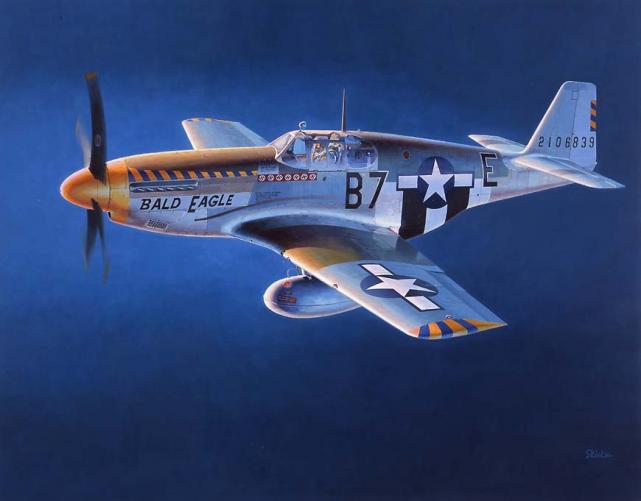
North American P-51B 'Mustang' © Shigeo Koike
Avec l'accord amical de M. Takenaka (www.ne.jp/asahi/airplane/museum) et de Fuji Heavy Industries Ltd (www.fhi.co.jp)
With courtesy of Mr. Takenaka (www.ne.jp/asahi/airplane/museum) and Fuji Heavy Industries Ltd (www.fhi.co.jp)
Anticipant une guerre proche, le gouvernement britannique, conscient de l'insuffisance de son potentiel industriel, envoya aux USA une délégation, menée par Henry Self et chargée d'apprécier les capacités américaines à les fournir en avions. Ce groupe visita entre autre la société North American Aviation, (N.A.A.) basée à Inglewood en Californie. Il lui acheta 200 avions d'entraînement, des AT-6 pourvus d'un train escamotable. Les modèles livrés furent le Harvard IIA (AT-6C) et Harvard III (AT-6D).
Anticipating the war to come, the British government, conscious of the weakness of its industrial potential, sent to the USA a delegation, headed by Henry Self and in charge of appreciating the American capacities to provide them in planes. This group visited the company North American Aviation, (N.A.A.) based in Inglewood in California. It bought there 200 training planes AT-6 fitted with a retractable landing gear. The models to be delivered were the Harvard IIA (AT-6C) and Harvard III (AT-6D).
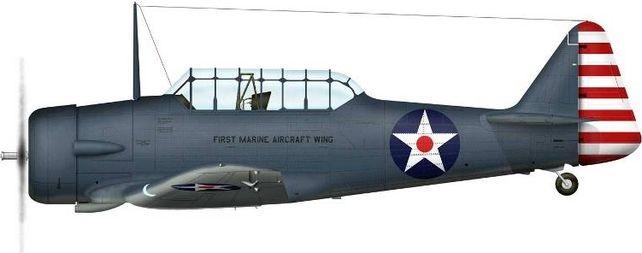
North American AT-6 Texan
© Srecko Bradic - www.letletlet-warplanes.com
Après la déclaration de guerre du 3 septembre 1939, une seconde commission retourna aux Etats-Unis pour acheter des chasseurs. En avril 1940, elle acheta des Curtiss P-40. Les américains n'étant pas sûrs de fournir ces P-40 dans des délais suffisants, les anglais demandèrent à la N.A.A., dirigée par James 'Dutch' Kindelberger, de fabriquer des P-40 Tomahawk sous licence. Kindelberger refusa mais proposa un chasseur équipé du même moteur Allison V-1710-39 mais plus performant.
After the declaration of war of September 3rd, 1939, a second commission went back to the United States to buy fighters. In April 1940, it bought Curtiss P-40s. Because the American were not sure to provide these P-40s in good times, the English asked the N.A.A., directed by James "Dutch" Kindelberger, to manufacture P-40 Tomahawks under license. Kindelberger refused and proposed a fighter fitted with the same engine Allison V-1710-39 but more powerful.
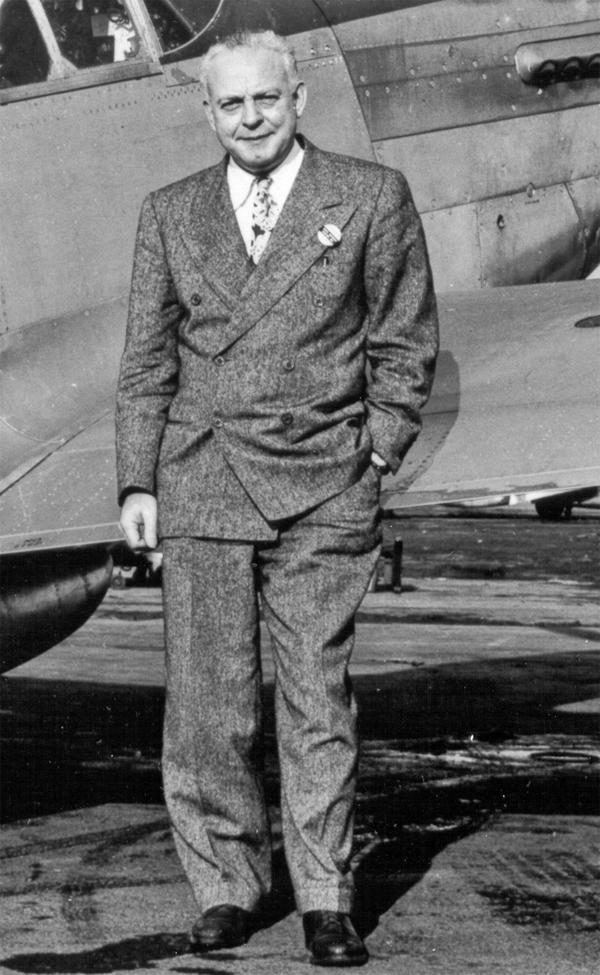 James Dutch Kindelberger
James Dutch Kindelberger
Photo : source inconnue - source unknown
Un projet fut très rapidement élaboré dans un hôtel à New-York et soumis à la British Purchasing Commission qui l'accepta le 24 avril 1940. Le prix fut ensuite négocié à 40 000 dollars par avion et un contrat pour 320 avions (NA-73) fut signé le 29 mai. L'U.S.A.A.C. n'étant pas intéressé par cet avion, celui-ci ne reçut pas d'appellation officielle américaine : il s'appela le NA-73. Ainsi était né le Mustang.
A project was very quickly elaborated in a hotel in New York and submitted to the British Purchasing Commission which accepted it on April 24th, 1940. The price was then negotiated to 40,000 dollars per plane and a contract for 320 planes (NA-73) was signed on May 29th. The U.S.A.A.C. was not interested by this plane and this one did not get an American official name : it was called the NA-73. Thus was the Mustang born.
LE PROTOTYPE NA-73X - THE PROTOTYPE NA-73X

© Greg Goebel - Domaine public, public domain
La N.A.A., n'ayant pas l'expérience de la fabrication d'avions de chasse, obtint de Curtiss toutes précisions utiles sur le P-40. Kindelberger s'engagea à réaliser le NA-73 en un temps record, 120 jours (le temps qu'il aurait fallu pour monter les chaînes d'assemblage du P-40). Raymond Rice, Chef Ingénieur du Bureau d'Etude et Edgar Schmued, Ingénieur Design (Allemand émigré aux USA au début des années trente) se mirent au travail le 30 mai.
The N.A.A., because of its lack of experience in fighter manufacturing, obtained from Curtiss all useful precise details on P-40. Kindelberger committed himself to create the NA-73 in a record time, 120 days (the time that would have been necessary to set up the assembly lines for the P-40). Raymond Rice, Chief Engineer of the Research Department and Edgar Schmued, Chief of Design (a German who emigrated in the USA in the early thirties) started to work on May 30th.
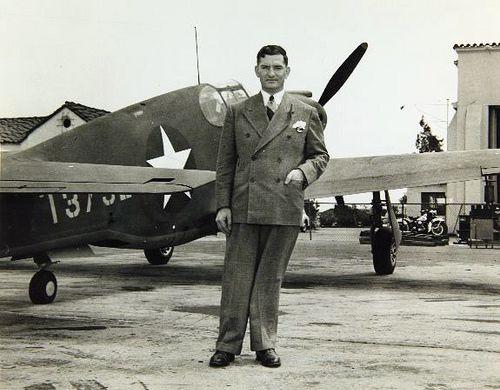
Edgar Schmued - P-51-2-NA (41-37322)
© San Diego Air & Space Museum (domaine public - public domain)
Leur objectif fut de diminuer le poids et la traînée de l'avion pour obtenir le meilleur rendement du moteur Allison : une seule entrée d'air sur le capot, une section de fuselage réduite au maximum, une verrière intégrée dans le fuselage. La prise d'air du radiateur fut logée au centre du fuselage entre les ailes.
Their goal was to decrease the weight and the trail of the plane to obtain the best output of the Allison engine : only one air intake on the engine hood, a section of fuselage reduced to the maximum, a canopy integrated in the fuselage. The radiator airscoop was located in the center of the fuselage under the wings.
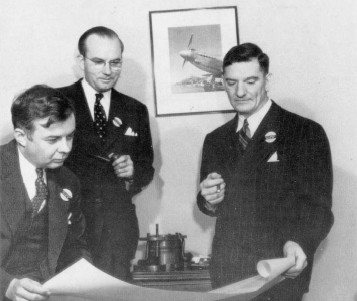
Louis Wait, Ray Rice, Edgar Schmued
(de gauche à droite - from left to right) © Boeing
L'armement comprenait 2 mitrailleuses Browning 53-2 calibre 0.50 dans le bas du capot moteur et 2 Browning MG40 calibre 0.30 dans chaque aile. Mais l'innovation du NA-73X était l'aile laminaire développée par le National Advisory Committee for Aeronautics (N.A.C.A.) qui diminuait la traînée et augmentait considérablement les performances de l'avion.
The armament consisted in 2 machine-guns Browning 53-2 gauges 0.50 in the bottom of the engine cowling and 2 Browning MG40 gauges 0.30 in each wing. But the innovation of the NA-73X was the laminar flow wing developed by the National Advisory Committee for Aeronautics (N.A.C.A.) which decreased the trail and increased the performances of the plane considerably.
COMPARAISON DE PROFILS D'AILES - WING PROFILES COMPARISON




P-51 D Mustang Fw 190 D-9




Spitfire Mk XIV Mitsubishi A6M5


F6F-3 Hellcat
Le 9 septembre 1940, 78 000 heures d'études et 127 jours après avoir découpé du métal, le NA-73X effectua du roulage à l'usine de Mines Field (Los Angeles), sans moteur mais avec des roues de T6 et surtout un nom, MUSTANG, donné par les Anglais, inspirés par une chanson célèbre sur un petit cheval sauvage, rapide et souple. Le moteur ne fut livré que le 7 octobre (l'U.S.A.A.C. avait en effet longtemps hésité à donner son feu vert car le moteur Allison était réservé en priorité aux Lockheed P-38, Curtiss P-40 et Bell P-39) et monté en 4 jours.
On September 9th, 1940, 78,000 engineering hours and 127 days after the metal was cut, the NA-73X was rolled out of the factory of Mines Field (Los Angeles), without engine but with wheels of T6 and above all a name, MUSTANG, given by the English who were inspired by a famous song about a small horse, wild, fast and flexible. The engine was delivered only on October 7th (the U.S.A.A.C. had hesitated a long time to give its agreement because the Allison engine was kept in priority for the Lockheed P-38, Curtiss P-40 and Bell P-39) and installed within 4 days.
 North American NA-73X
North American NA-73X
Profil source inconnue, Profile source unknown)
Les premiers essais moteur débutèrent le 11 octobre 1940 et le 26, le NA-73X vola pour la 1ère fois piloté par le pilote d'essai Vance Breese à Mines Field (code NX-19998 sur les ailes et le gouvernail). Le 20 novembre, le pilote Paul Balfour, oubliant de basculer sur le second réservoir se crasha et se retourna : le pilote était sauf mais l'avion ne vola plus avant le 11 janvier 1941, piloté par Bob Chilton. Après 45 vols, il fut retiré du service le 15 juillet.
The first engine tests began on October 11th, 1940 and on the 26, the NA-73X took off for the 1st time flown by the test pilot Vance Breese at Mines Field(code NX-19998 on the wings and the tail). On November 20th, the pilot Paul Balfour, forgetting to switch on the second tank, crashed and flipped over : the pilot was safe but the plane could not fly again before January 11th, 1941, flown by Bob Chilton. After 45 flights, it was retired on July 15th.
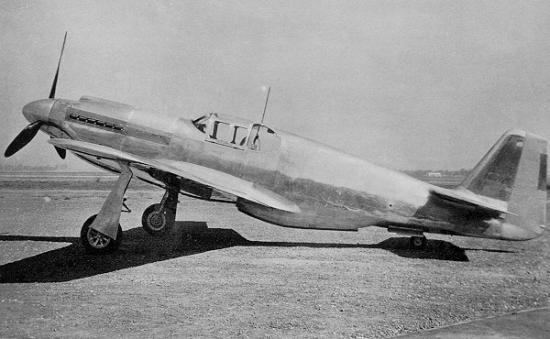
Prototype NA-73X - A la sortie de l'atelier - Right out of the workshop
(source inconnue, probablement U.S.A.F. ou N.A.A. - Source unknown, probably U.S.A.F. or N.A.A.)
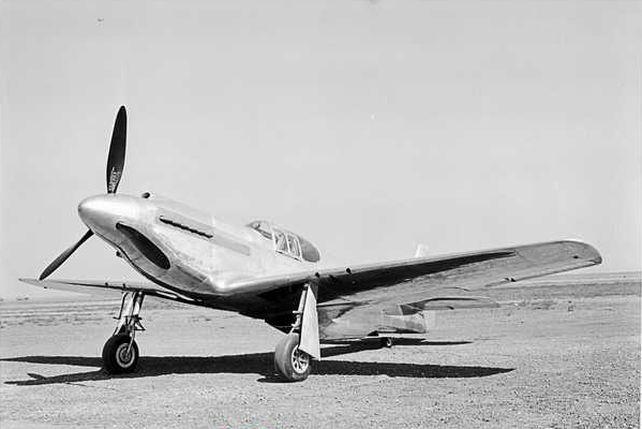
Prototype NA-73X
(source inconnue, probablement U.S.A.F. ou N.A.A. - Source unknown, probably U.S.A.F. or N.A.A.)
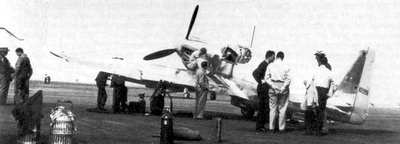
Prototype NA-73X
(source inconnue, probablement U.S.A.F. ou N.A.A. - Source unknown, probably U.S.A.F. or N.A.A.)
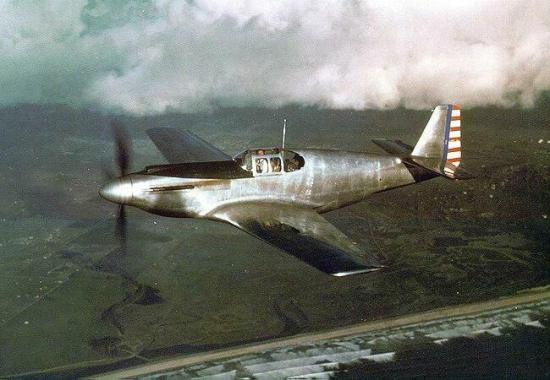
Prototype NA-73X - En vol - In flight
(source inconnue, probablement U.S.A.F. ou N.A.A. - Source unknown, probably U.S.A.F. or N.A.A.)
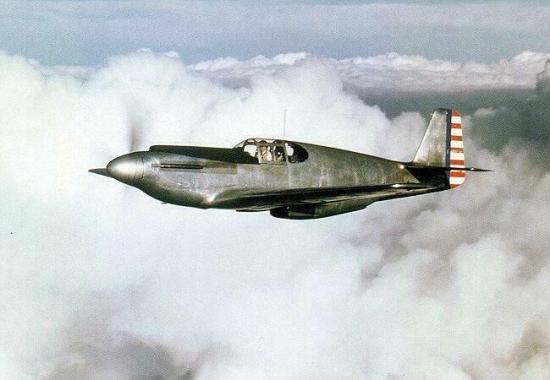
Prototype NA-73X - En vol - In flight
(source inconnue, probablement U.S.A.F. ou N.A.A. - Source unknown, probably U.S.A.F. or N.A.A.)
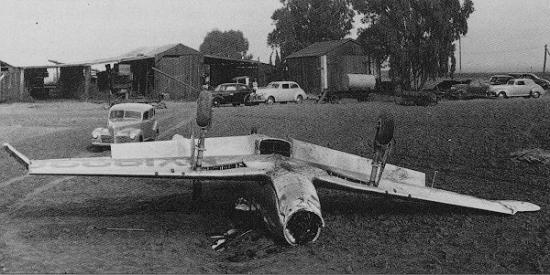
Prototype NA-73X - Après le crash de Paul Balfour - After the crash with Paul Balfour
(source inconnue, probablement U.S.A.F. ou N.A.A. - Source unknown, probably U.S.A.F. or N.A.A.)
Les essais du prototype révélèrent un défaut de surchauffe moteur qui conduisit à l'amélioration du refroidissement. Mais le NA-73X se révéla très performant et maniable et il surclassait le Curtiss P-40. Satisfaits, les anglais commandèrent 300 autres exemplaires (NA-83) en demandant néanmoins d'intégrer quelques modifications (résultant des expériences anglaises de combat en Europe).
The tests of the prototype revealed a defect of engine overheating which led to the improvement of cooling system. But the NA-73X appeared very powerful and handy and it outclassed the Curtiss P-40. Satisfied, the English ordered 300 extra units (NA-83) while asking nevertheless to integrate some modifications (resulting from the English experiments of fighting in Europe).
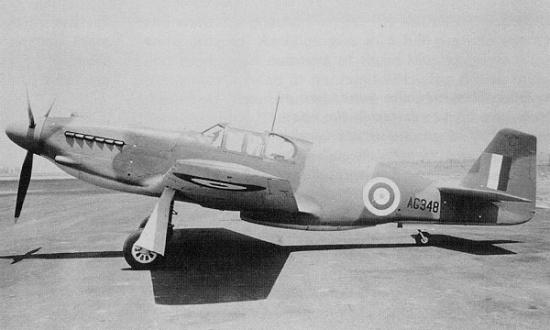
Mustang I (AG348)
(source inconnue, probablement U.S.A.F. ou N.A.A. - Source unknown, probably U.S.A.F. or N.A.A.)
En parallèle, l'U.S.A.A.C. demanda pour évaluation 2 prototypes désignés XP-51 (s/n AG348 et AG354 de la 1ère commande anglaise : ils reçurent les numéros 41-038 et 41-039) ; ceux-ci furent expédiés à Wright-Patterson Field (Ohio). Quant à la British Purchasing Company, elle demanda par courrier en novembre 1940 que l'avion soit appelé MUSTANG, se référant à une chanson des années trente vantant la rapidité et la souplesse d'un petit cheval sauvage de l'Ouest.
In parallel, the U.S.A.A.C. required for evaluation 2 prototypes that they called XP-51 (s/n AG348 et AG354 in the 1st british order : they received the numbers 41-038 and 41-039) ; those were shipped to Wright-Patterson Field (Ohio). As for the British Purchasing Company, it asked by mail in November 1940 the plane to be called MUSTANG, referring to a song of the thirties praising the speed and the flexibility of a small wild horse of the West.
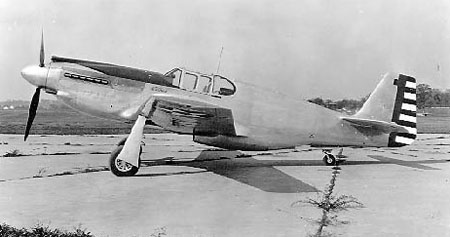
1st prototype XP-51(41-038) - 16/10/1941 - Wright Field
(source : National Museum of the U.S.A.F. - Photo USAF - Domaine public - Picture U.S.A.F. - Public domain)

1st prototype XP-51(41-038)
(source : National Museum of the U.S.A.F. - Photo USAF - Domaine public - Picture U.S.A.F. - Public domain)

2nd prototype XP-51(41-039)
(source U.S.A.F. - Domaine public - Source U.S.A.F. - Public domain )
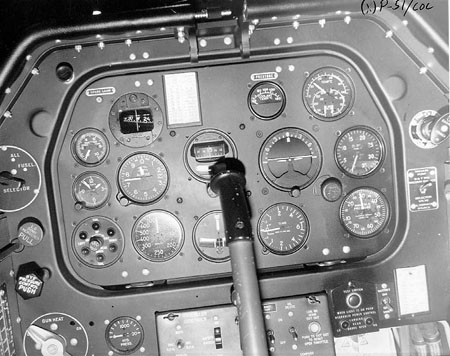
Cockpit XP-51(41-039)
(source : National Museum of the U.S.A.F. - Photo USAF - Domaine public - Picture U.S.A.F. - Public domain)
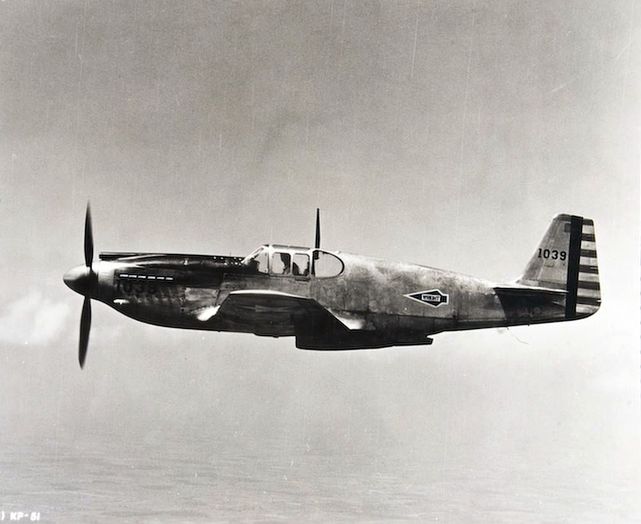
2nd prototype XP-51(41-039)
(source : National Museum of the U.S.A.F. - Photo USAF - Domaine public - Picture U.S.A.F. - Public domain)
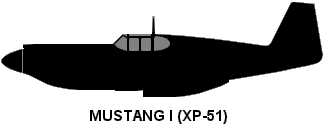
© Greg Goebel - Domaine public, public domain

2nd prototype XP-51(41-039) © Jean-Marie Guillou
P-51-NA / Mustang I & IA
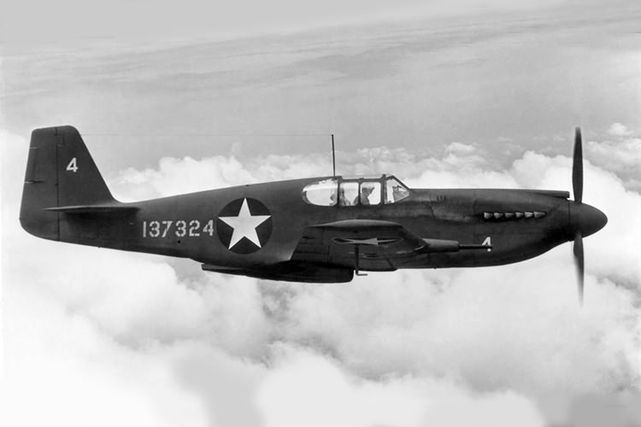
Mustang P-51-2-NA Apache, ex-FD421
© USAF (domaine public - public domain)
Les Mustang furent "prêtés" aux Anglais dans le cadre de la loi Prêt-Bail de mars 1941 : c'est pourquoi ils conservaient leur appellation américaine P-51. Les 320 premiers avions commandés (Mustang Mk I) devaient recevoir les numéros AG345 à AG664.
The Mustang were "lent" to the English within the Lend-Lease program of March 1941 : this is why they kept their American name P-51. The first 320 aircrafts ordered (Mustang Mk I) got the numbers AG345 to AG664.
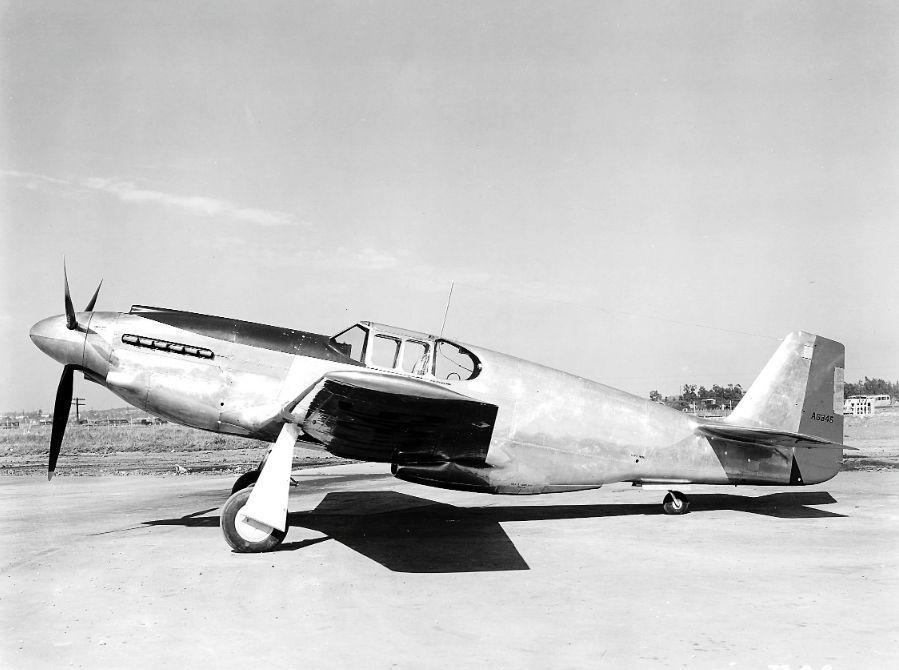
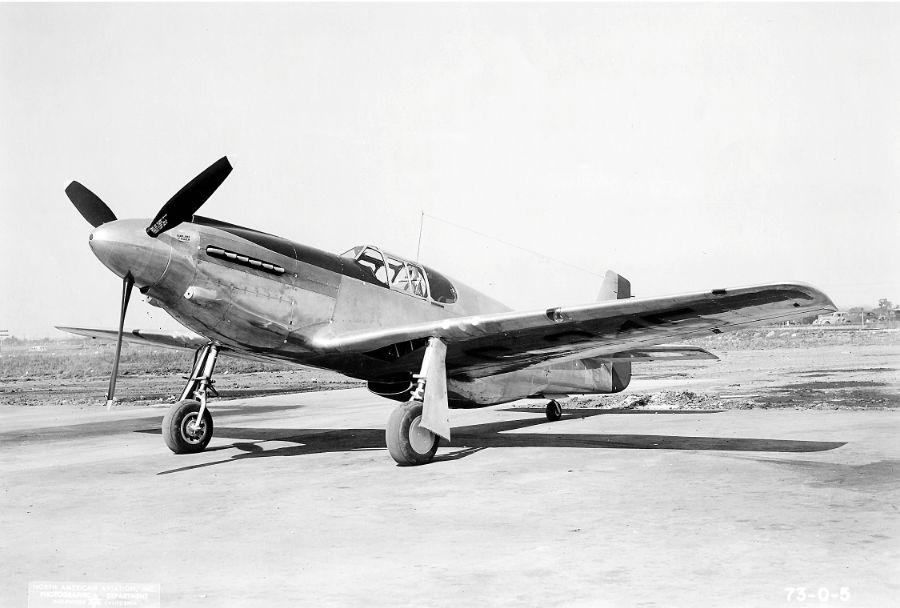
Mustang I (AG345), Mine Fields
© North American Aviation
Le premier Mustang I de production (s/n AG345) vola le 23 (ou 25 ?) avril 1941 et fut accepté par la British Purchasing Commission le 1er mai.
The first manufactured Mustang I (s/n AG345) flew on the 23rd (or 25th ?) April, 1941 and was accepted by British Purchasing Commission on May 1st.
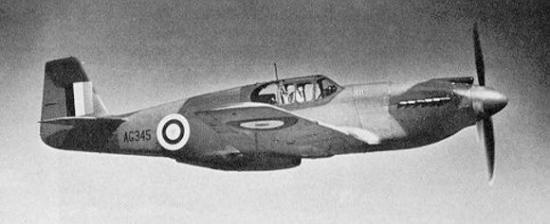
Mustang I (AG345)
(source inconnue, probablement U.S.A.F. ou N.A.A. - Source unknown, probably U.S.A.F. or N.A.A.)
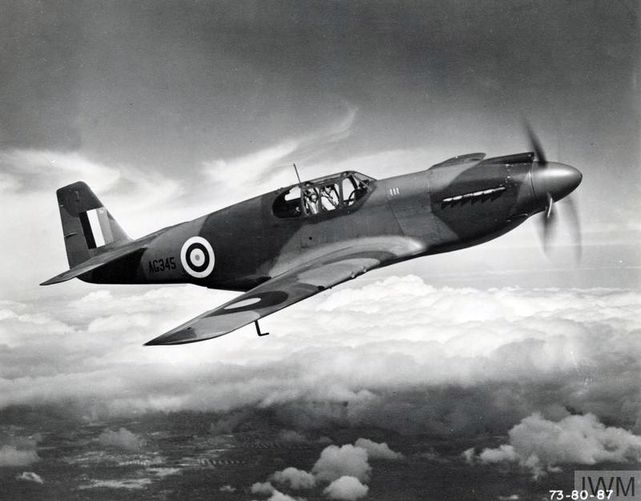
Mustang I (AG345)
© Imperial War Museum
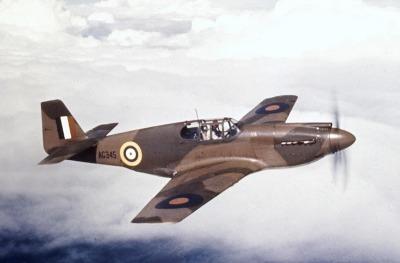
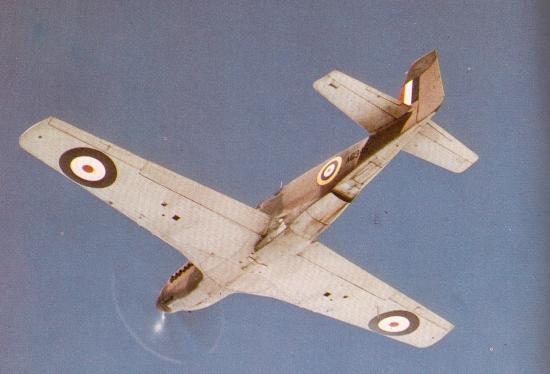
Mustang I (AG345)
(source inconnue, probablement U.S.A.F. ou N.A.A. - Source unknown, probably U.S.A.F. or N.A.A.)

Le second Mustang I (s/n AG346) fut envoyé en Angleterre en septembre et arriva le 24 octobre à la base RAF de Burtonwood pour des tests. Ces tests révélèrent la supériorité du Mustang sur le Spitfire Mk Vb. Le Mustang AG346 sera abattu par la Flak à Gacé (Orne), le 20 août 1944 et son pilote, le Flight Lt. D. Clark, du 168 Sqn, sera mortellement blessé.
The second Mustang I (s/n AG346) was shipped in England in September and arrived on the 24th, October ar RAF Burtonwood base for tests. These tests revealed the superiority of the Mustang on the Spitfire Mk Vb. The Mustang AG346 was shot down by the Flak at Gacé (Orne, Normandy, France), on August 20th, 1944 and its pilot, Glight Lt. D. Calrk from Sqn 168, was killed.
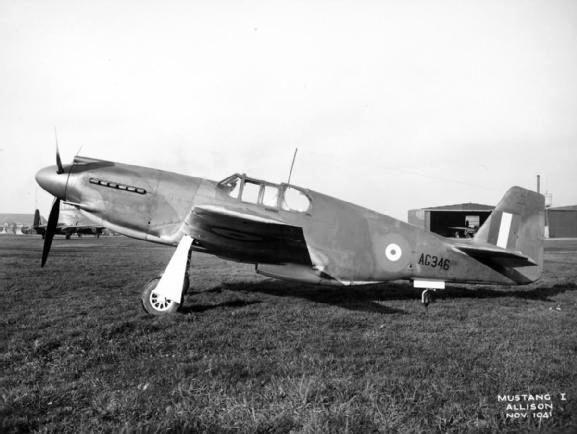
Mustang I (AG346), Speke Aerodrome - Angleterre, 15 novembre 1941, England, 15th November, 1941
© Imperial War Museum
Mais le Mustang avait toutefois un défaut : ses qualités de vols étaient diminuées à partir de 3 440 m et même difficiles au-dessus de 6 100 m. C'est pourquoi les anglais privilégièrent le Spitfire comme intercepteur et reléguèrent le Mustang aux missions d'appui de l'armée de terre.
But the Mustang had however a defect : its flight qualities were reduced above 3,440 m and even difficult above 6,100 m. For this reason, the English chose the Spitfire as an interceptor and relegated the Mustang to support missions for the Army.

Mustang I (AG346)
(source inconnue, probablement U.S.A.F. ou N.A.A. - Source unknown, probably U.S.A.F. or N.A.A.)
Les 300 Mustang I supplémentaires commandés par les anglais (NA-83) reçurent les numéros AL 958 à 999, AM 100 à 257 et AP 164 à 263.
The 300 extra Mustang I ordered by the British (NA-83) got the numbers AL 958 to 999, AM 100 to 257 and AP 164 to 263.
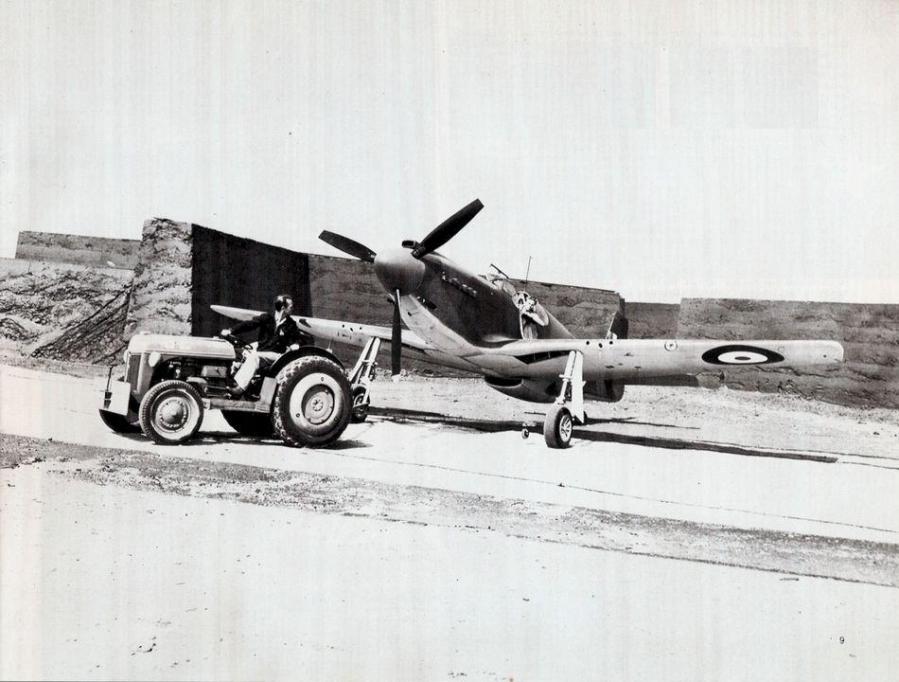
Mustang I
Repoussé dans son emplacement en Grande-Bretagne - Backed into its revetment in Great Britain
© North American Aviation
Au fur et à mesure des livraisons, assez lentes, des modifications furent apportées : l'entrée d'air du radiateur fut élargie et celle au dessus du capot allongée. Le pare-brise frontal monopièce arrondi fut remplacé par un pare-brise en 3 pièces dont la pièce centrale à l'épreuve des balles.
During the first deliveries, rather slow, modifications were made : the air intake of the radiator was widened and the other one on top of the hood lengthened. The frontal rounded windscreen in one piece was replaced by a three-piece unit with a central part bulletproof.
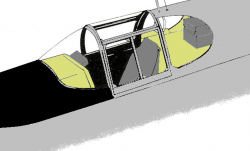
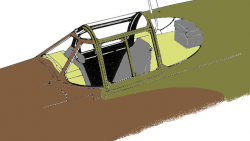
NA-73X Mustang I
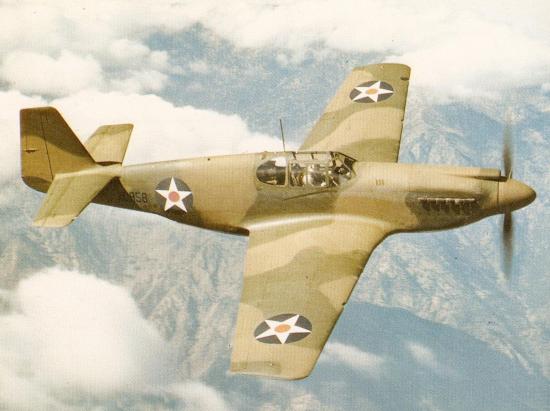
Mustang I (AL958) - Cocardes américaines provisoires - Temporary american stars
(source inconnue, probablement U.S.A.F. ou N.A.A. - Source unknown, probably U.S.A.F. or N.A.A.)
150 avions supplémentaires (NA-91) furent commandés par les Américains pour les Anglais (loi Prêt-Bail) le 25 Septembre 1941 : baptisés initiallement P-51 Apache par l'USAAF, ils furent finalement appelés Mustang Mk IA par les Anglais.
150 additional planes (NA-91) were ordered by the American for the English (Lend-Lease program) on the 25th September 1941 : initially named P-51 Apache by the USAAF, they were finally called Mustang Mk IA by the English.
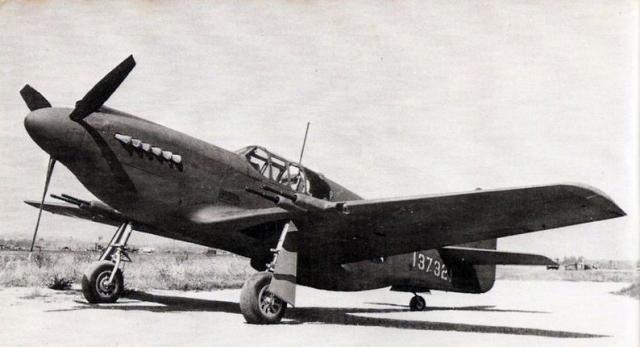
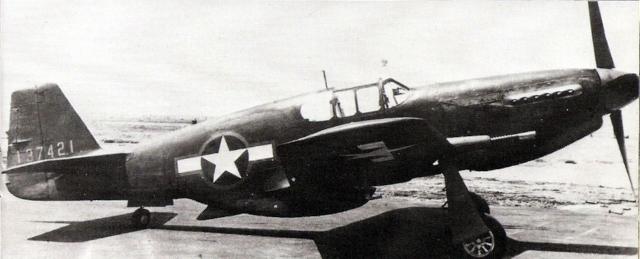
Mustang P-51-2 Apache s/n 41-37321
Photo : source inconnue - source unknown
Le Mk IA était similaire au Mk I sauf pour l'armement : les 4 mitrailleuses d'ailes étaient remplacées par 4 canons Hispano Mk II de 20 mm (.79 in). Les numéros de série RAF assignés à ces 150 avions furent FD418 à FD567. Leur numéros US étaient 41-37320 à 41-37469.
The Mk IA was similar to the Mk I except for the armament: the 4 machine-guns in the wings were replaced by 4 guns Hispano Mk II of .79 in (20 mm). The RAF serial numbers assigned for these 150 units were FD418 to FD567. Their US designation was serials 41-37320 to 41-37469.
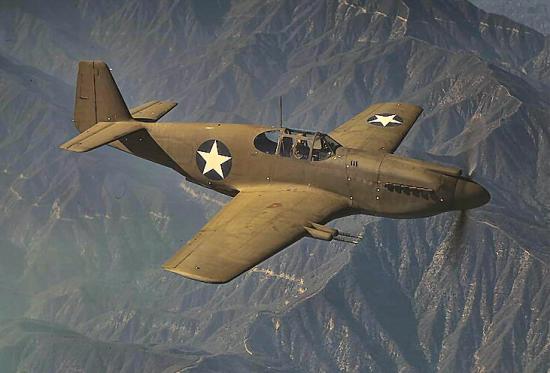
Mustang Mk IA - Octobre 1942 - October 1942
© United States Library of Congress # LC-DIG-fsac-1a35324 (http://www.loc.gov) - Auteur/author : Alfred T. Palmer
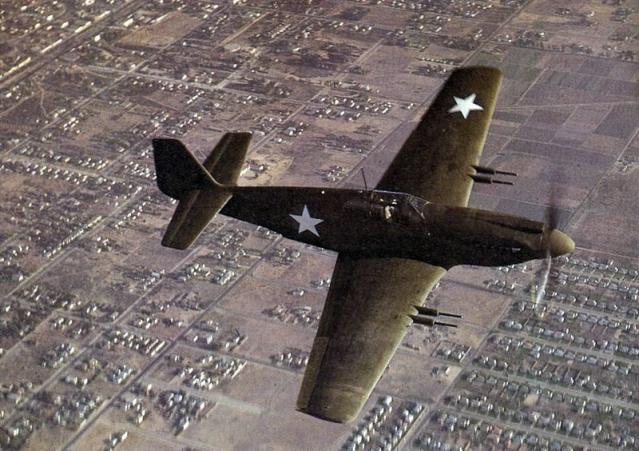
Mustang P-51 Apache
Photo : source inconnue - source unknown
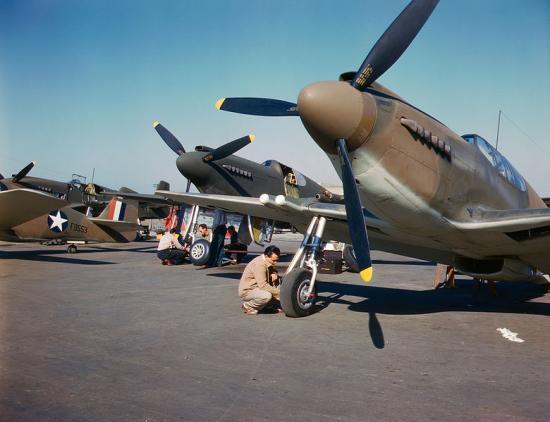
Mustang Mk IA FD553 - Inglewood, Californie - Octobre 1942 - Inglewood, California - October 1942
© United States Library of Congress # LC-DIG-fsac-1a35322 (http://www.loc.gov) - Auteur/author : Alfred T. Palmer
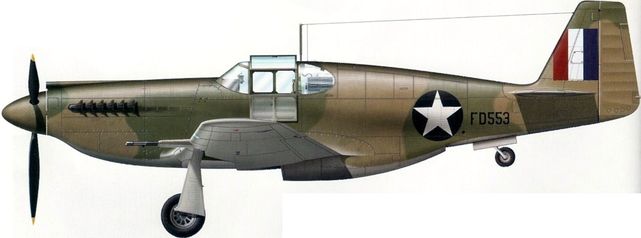
Mustang P-51-NA (41-37455, ex FD553) - Inglewood, Californie, 1942
© Jean-Marie Guillou
Après Pearl-Harbor, les américains réquisitionnèrent 55 P-51-NA (Mustang "Apache") de ces 150 avions et les équipèrent de caméras pour effectuer des missions de reconnaissance au dessus des USA sous le nom de F-6A.
After Pearl-Harbor, American requisitioned 55 P-51-NA (Mustang "Apache") out of these 150 aircrafts and equipped them with cameras to carry out reconnaissance missions over the USA under the name F-6A.
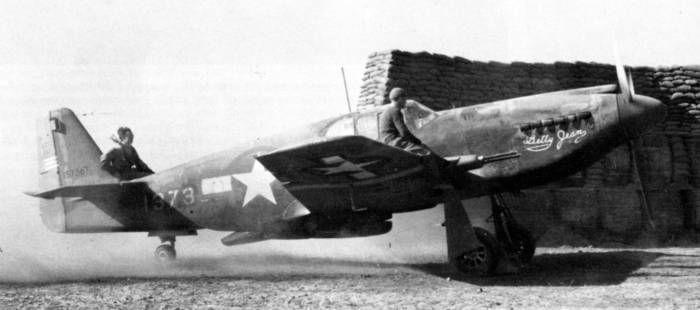
Mustang P-51-2 'Betty Jean' (s/n 41-37367), 111th TRS 68th TRG, Anzio (Italie/Italy)
© USAF (domaine public - public domain)

Mustang P-51, Alaska 1943
© USAF (domaine public - public domain)
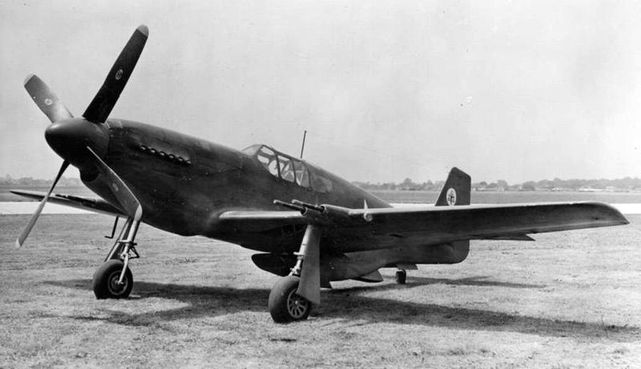
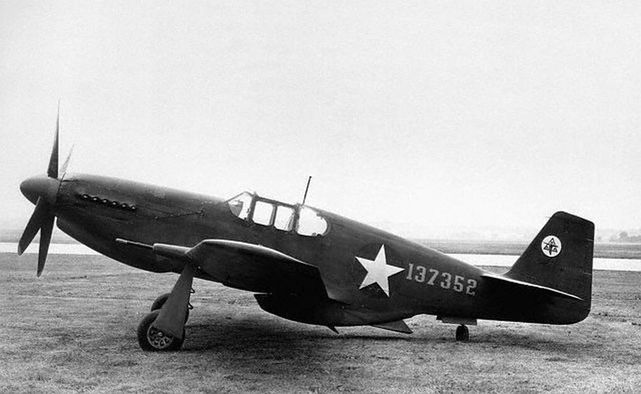
Mustang XP-51B (41-37352, ex FD450)
© USAF (domaine public - public domain)
Ils gardèrent également 2 prototypes équipés du moteur Packard (Merlin) : ils reçurent la désignation de XP-78 (NA-101 chez N.A.A.) et plus tard XP-51B. Ils servirent de modèle pour le prototype du P-51 B
They also kept 2 prototypes equipped with Packard (Merlin) engine : they got the designation XP-78 (NA-101 at N.A.A.) and later XP-51B. They were used as model for the prototype of P-51 B.
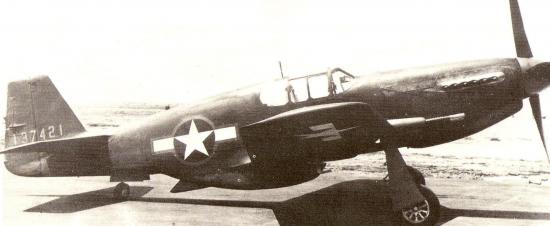
XP-51 B (s/n 41-37421)
(source inconnue, probablement U.S.A.F. ou N.A.A. - Source unknown, probably U.S.A.F. or N.A.A.)
Le Squadron 26, basé à Gatwick, fut le premier équipé de Mustang en janvier 1942. L'épreuve du feu arriva le 10 mai 1942 quand un Mustang du SQN 26 effectua une mission de reconnaissance au dessus du terrain de Berck, mitraillant quelques véhicules et sur le chemin du retour un train de marchandises.
The Squadron 26, based in Gatwick, was the first unit equipped with Mustang in January 1942. The first war action occured on May 10th, 1942 when a Mustang of the SQN 26 flew for a reconnaissance mission over Berck's airfield, machine-gunning some vehicles and shooting a train on the way back.
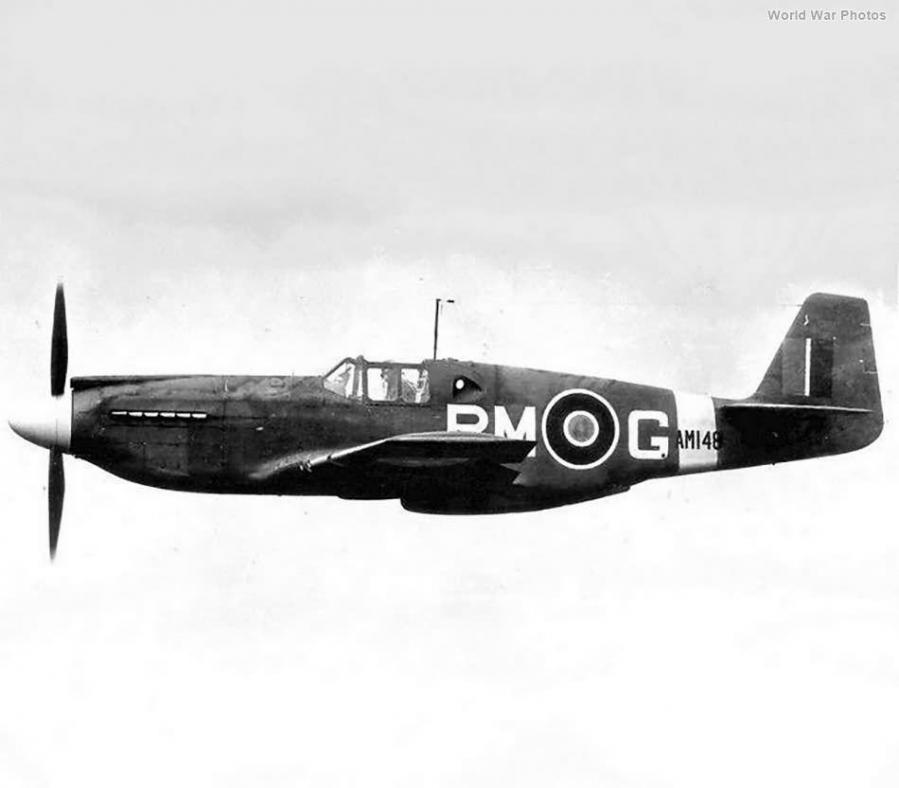
Mustang I (AM148) n° 26 Squadron
Photo : auteur inconnu - author unknown
En juillet 1942, le Mustang n° AG415, en mission de "strafing" dans la région du Touquet, fut le premier Mustang abattu.
In July 1942, the Mustang # AG415, in mission of "strafing" in the area of Le Touquet, was the first Mustang shot down.
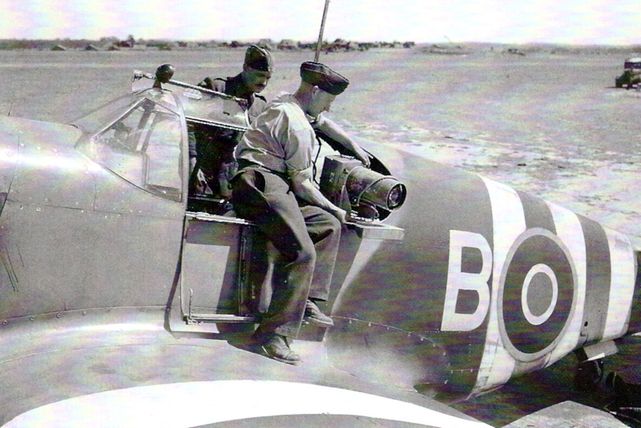
Mustang Mk IA , No 35 (Reconnaissance) Wing, Gatwick (Sussex)
Les mécaniciens installent une caméra Type F.24 en juin 1944
The mechanics install a camera Type F.24 in June, 1944
© USAF (domaine public - public domain)

Mustang Mk IA (FD474)
© USAF (domaine public - public domain) - Photo Robert Astrella
A-36A
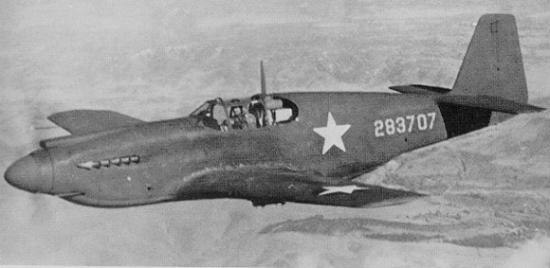
A-36A (source inconnue, probablement U.S.A.F. ou N.A.A. - Source unknown, probably U.S.A.F. or N.A.A.)
Le succès du Junkers 87 en Europe amena la N.A.A. à proposer à l'U.S.A.A.F. une version de bombardier en piqué. L' U.S.A.A.F. (Fighter Project Officer Benjamin S. Kelsey) commanda le 16 avril 1942 500 P-51 (NA-97) qui furent appelés A-36 'Invader' (A pour Attack) puis livrés à partir de septembre 1942 sous le nom A-36A (s/n 42-83663 à 42-84162).
The success of THE Junkers 87 in Europe led the N.A.A. to propose to the U.S.A.A.F a version of dive bomber. The U.S.A.A.F. (Fighter Project Officer Benjamin S. Kelsey) ordered on the 16th April, 1942 500 P-51 (NA-97) which was called A-36 'Invader' (A for Attack) and then delivered in September 1942 under the name A-36A (s/n 42-83663 to 42-84162).
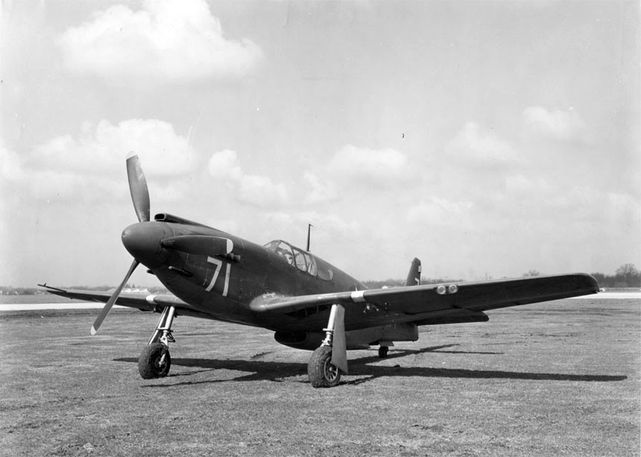
North American A-36 (42-83671)
Usine d'Ingelwood, Californie - Inglewood manufacture, California.
© USAF - Domaine public - Public domain
Le A-36A avait la cellule du P-51 et le moteur Allison V-1710-87 (1325 CV) mais sa structure était renforcée pour les attaques en piqué.
The A-36A had the cell of the P-51 and the V-1710-87 Allison engine (1,325 HP) but its structure was reinforced for the dive bombings.
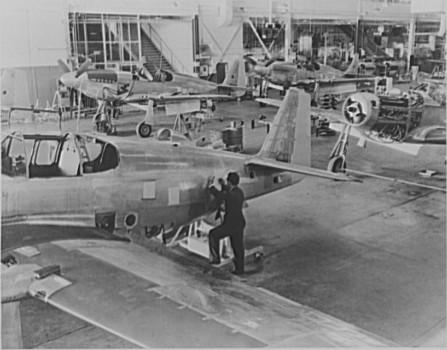 North American A-36A
North American A-36A
Usine d'Ingelwood, Californie, octobre 1942 - Inglewood manufacture, California, October 1942
© US government - Domaine public - Public domain
Les ailes furent dotées de lance-bombes et de freins de piqué, car si l'A-36 était plus rapide que le Ju 87, sa grande vitesse devenait un handicap pour la précision en piqué. Les 4 mitrailleuses de 0.30 furent remplacées par des calibres 0.50 (soit 6 mitrailleuses 0.50 en tout). Mais les pertes par la DCA entraînèrent l'U.S.A.A.F. à modifier sa tactique de bombardement (largage des bombes à 1200/1500 m au lieu de 600/1200 m).
The wings were equipped with bomb thrower and diving brakes, because if the A-36 was faster than the Ju 87, its great speed was a hindrance for accuracy when diving. The 4 machine-guns of 0.30 were replaced by gauges 0.50 (which meant 6 machine guns 0.50 in total). But the losses by the Flak pushed the U.S.A.A.F. to modify its bombardment tactic (dropping bombs at 1200/1500 m instead of 600/1200 m).

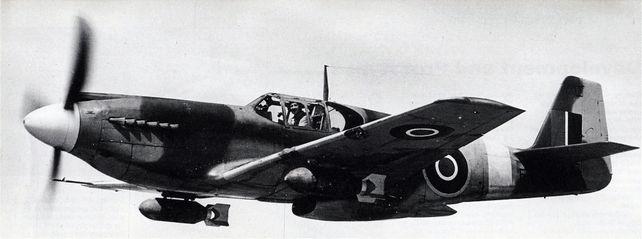
A-36A EW998, RAF - 1943
© UK government - Domaine public - Public domain
Le premier A-36A (s/n 42-83663) fut fabriqué en septembre 1942 et entra en service en octobre. Les 27th et 86th Fighter Bomb Groups furent les premières unités équipées au printemps 1943 en Afrique du Nord. Le 27th FBG mena le premier A-36A au combat lors de l'attaque de l'aérodrome allemand de Pantelleria en juin. L'A-36A s/n 42-83865 fut livré en mars 1943 à la Grande-Bretagne pour de essais. Il fut immatriculé EW998.
The first A-36A (s/n 42-83663) was manufactured in September 1942 and entered in service in October. The 27th and 86th Fighter Bomb Groups were the first units equipped in spring 1943 in North Africa. The 27th FBG led the first A-36A to the fight during the attack of the German airfield of Pantelleria in June. The A-36A s/n 42-83865 was delivered in march 1943 to Great Britain for tests. It was registered EW998.
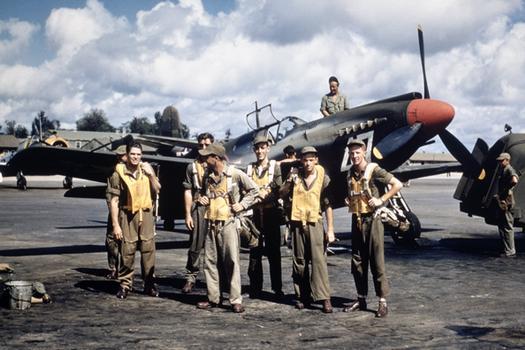
A-36A Invader, 1943
Entraînement en Louisiane - Training in Louisiana
© U.S.A.F. - Domaine public - Public domain
Puis, les deux groupes participèrent à l'invasion de la Sicile en juillet. Malheureusement, le A-36A présentait des défauts sur les ouvertures de freins de piqué (déséquilibre) entraînant des pertes de contrôle. Des modifications furent apportées.
Then, the two groups took part in the invasion of Sicily in July. Unfortunately, the A-36A presented defects on the opening of diving brakes (imbalance) involving losses of control. Modifications were done.
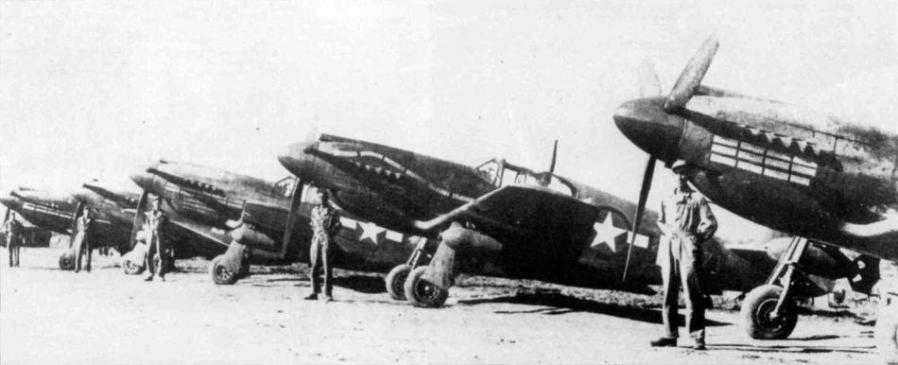
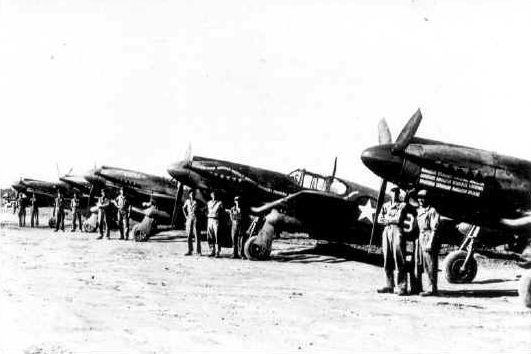
North American A-36A
86th FBG selon le/according to 86th FBG ou/or 27th FBG, 12th AF selon une autre source, according to another source, Italie/Italy, 1944
Le 2e avion (code B) serait le s/n 42-84071, assigné au 527th FBS, 86th FBG - The 2nd aircraft would be s/n 42-84071, assigned to 527th FBS of the 86th FBG
© North American Aviation
P-51A-NA

Mustang P-51A (s/n 43-6246) - Army Air Forces Tactical Center Orlando
© U.S.A.F. - Domaine public - Public domain
Le 23 juin 1942, une commande de 1 200 P-51A (NA-99) fut passée par la RAF dans le cadre de la loi Prêt-Bail mais fut réduite plus tard à 310 avions. Seule une cinquantaine fut livrée sous le nom Mustang Mk II. 35 avions furent en outre équipés de caméras K-24, rebaptisés F-6B et utilisés par l'U.S.A.A.F.
On June 23rd, 1942, an order of 1,200 P-51A (NA-99) was placed by the RAF within the Lend-Lease program but was later reduced to 310 units. Only about fifty were delivered under the name Mustang Mk II. Moreover, 35 aircrafts were equipped with K-24 cameras, were renamed F-6B and used by the U.S.A.A.F.
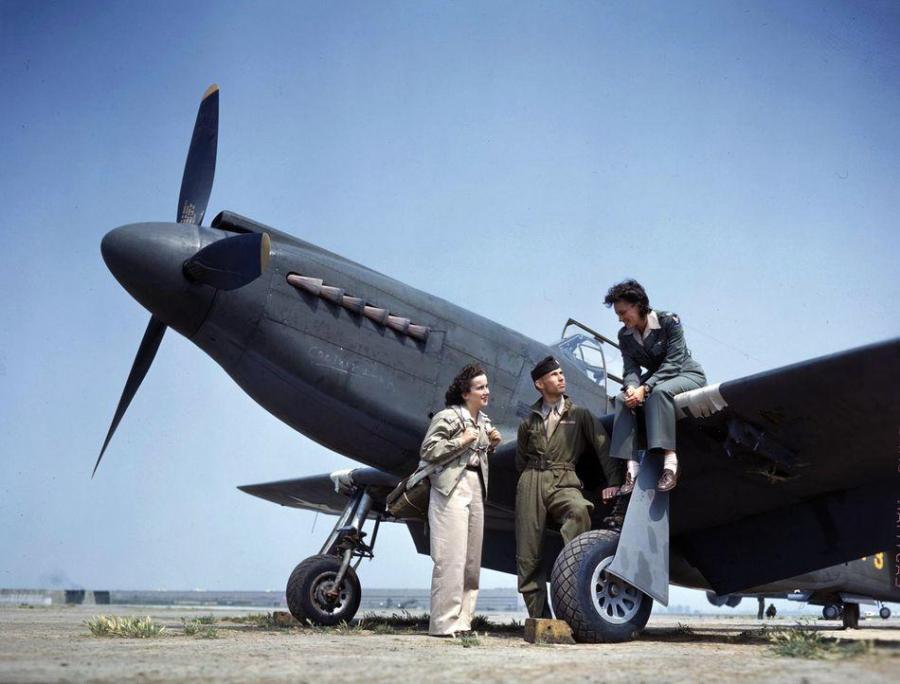
Mustang P-51A - Long Beach, California, Juin/June 1942
Barbara Jane Erikson (WASP), Lt Grover Bryan, Evelyn Sharp (WASP)
© U.S.A.F. - Domaine public - Public domain
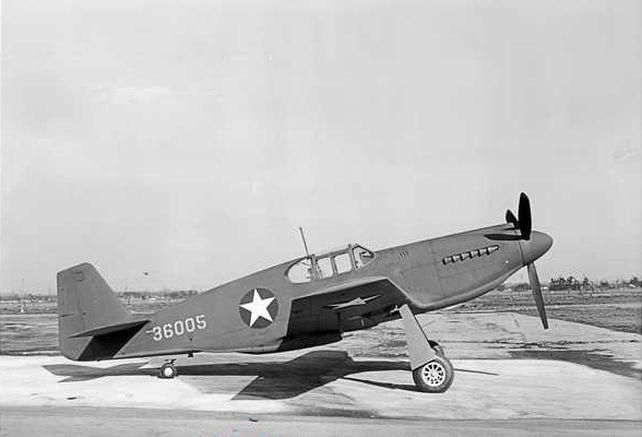
Mustang P-51A (43-6005) - © USAF - Domaine public - Public domain
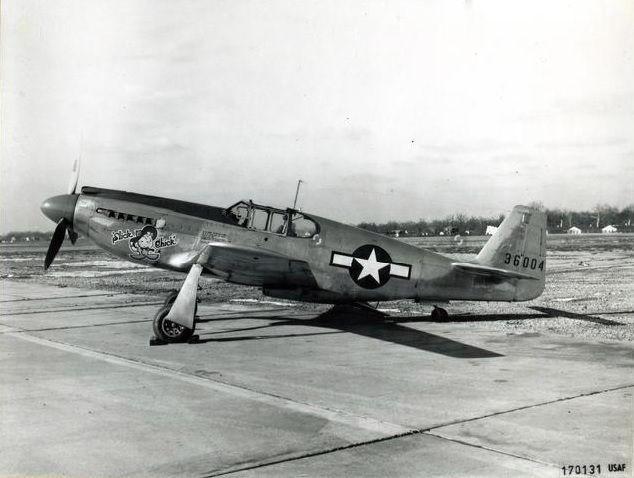
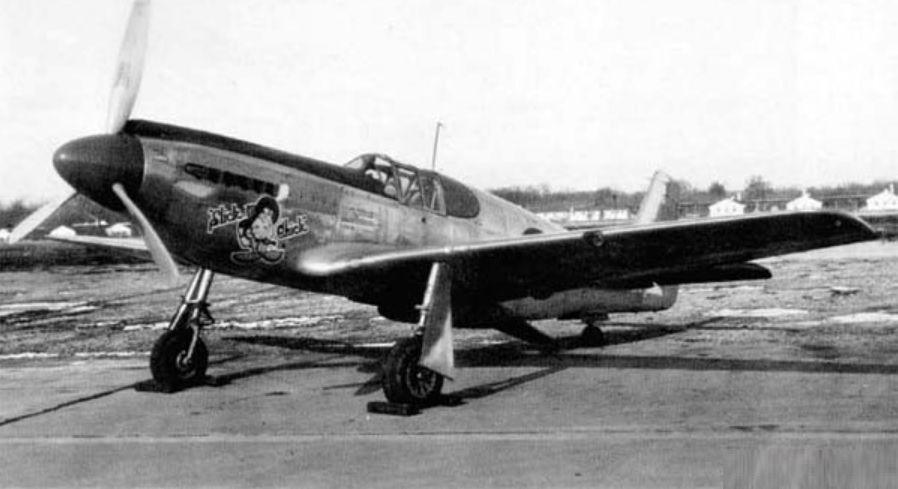
Mustang P-51A-1-NA "Slick Chick" (s/n 43-6004)
Le 2nd P-51A à sortir des chaînes de production - The 2nd P-51A off the production lines
© USAF - Domaine public - Public domain - National Museum of the U.S.A.F.
Les modèles suivants furent envoyés sur les théâtres de Chine, Indes et Birmanie. Ces 310 modèles reçurent les numéros 43-6003 à 43-6312. Le premier modèle (s/n 43-6003) fut transformé pour des essais avec skis.
The other models were sent on the China, Indies and Burma theaters. These 310 models got the numbers 43-6003 to 43-6312. The first unit (s/n 43-6003) was modified for ski testing.
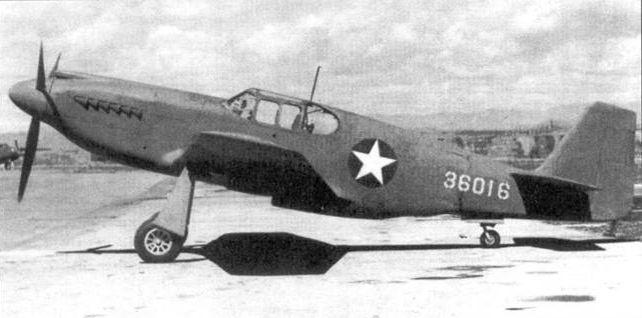
Mustang P-51A (43-6016) - © USAF - Domaine public - Public domain
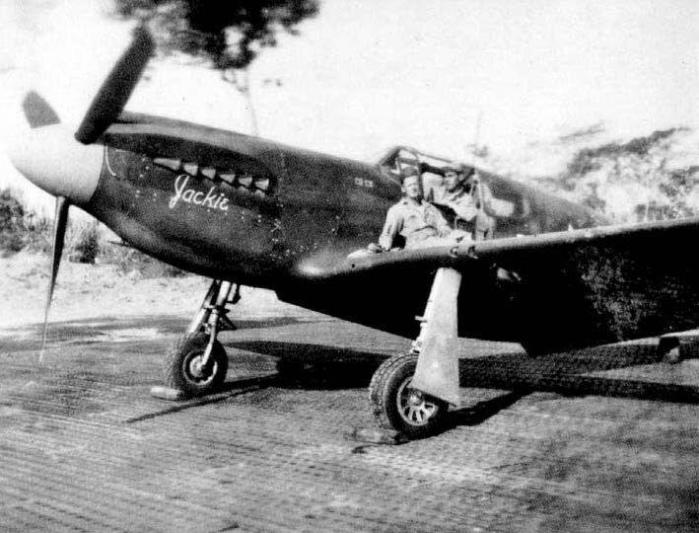
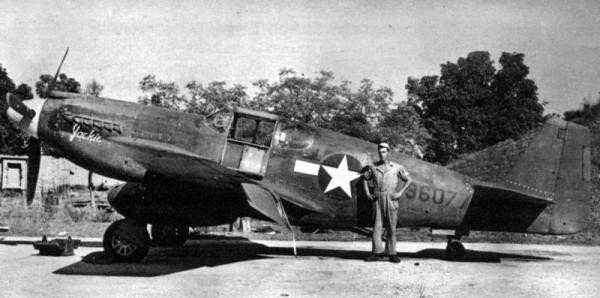
Mustang P-51A 'Jackie' (43-6077), Capt. J.J. England
Avion payé par les employés de la Universal Engineering Co., Michigan.
Aircraft paid by the employees of Universal Engineering Co., Michigan.
© USAF - Domaine public - Public domain
Le P-51A était équipé de deux mitrailleuses Browning de 12.7 mm (0.50 in.) dans chaque aile et du moteur Allison V-1710-81 de 1200 CV, une évolution plus puissante du -39.
The P-51A was fitted with two 12.7 mm (0.50 in.) Browning machine-guns in each wing and an engine Allison V-1710-81 of 1,200 HP, a more powerful evolution of the -39.
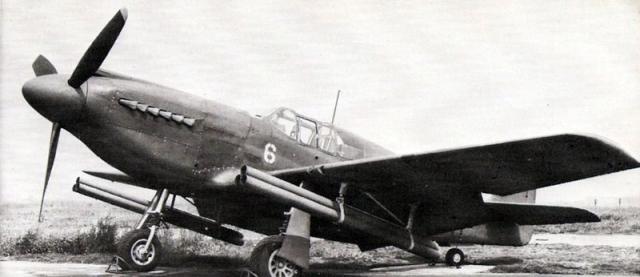
Mustang P-51A
Photo : auteur inconnu - author unknown
Il avait également des rateliers d'ailes pour recevoir des bombes, des lance-roquettes ou des réservoirs auxiliaires augmentant l'autonomie à 4 410 kms (2,740 mi.).
It also had wing racks to carry bombs, rockets or auxiliary tanks increasing autonomy up to 2,740 miles (4,410 kms).
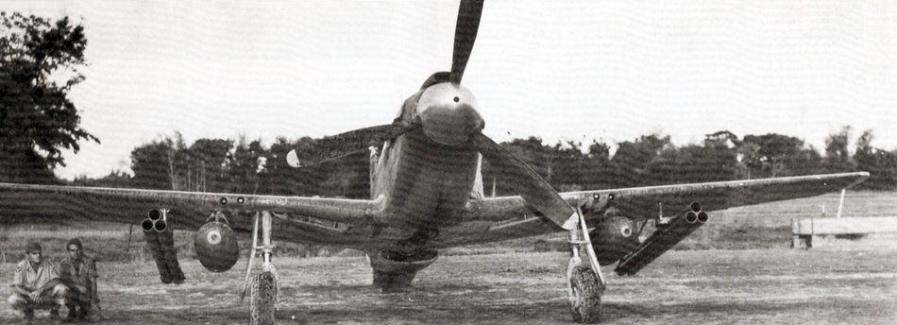
Mustang P-51A, 311th FBG, Dinjin, Inde/India avec/with bazookas
Photo : auteur inconnu - author unknown
Finalement, 1 580 appareils plus 1 prototype furent équipés du moteur Allison dont 764 pour la RAF. Certains modèles destinés à la RAFn'arrivèrent jamais à destination, leur bateau ayant été coulé par la Kriegsmarine pendant leur transfert. 10 appareils furent envoyés en Union Soviétique pour des essais.
Finally, 1,580 aircrafts plus 1 prototype were fitted with the Allison engine, including 764 for the RAF. Some units for the RAF never reached their final destination, their ship being sunk by the Kriegsmarine during their transfer. 10 aircrafts were shipped to Soviet Union for trials tests.
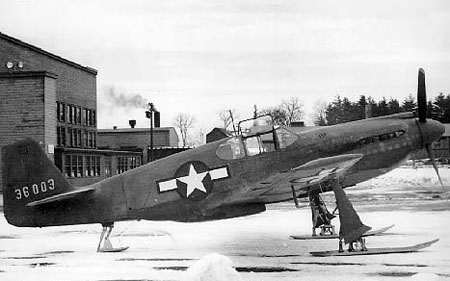
1st P-51A-NA(43-6003) - Tests de ski - Ski testing
(source : National Museum of the U.S.A.F. - Photo USAF - Domaine public - Picture U.S.A.F. - Public domain)
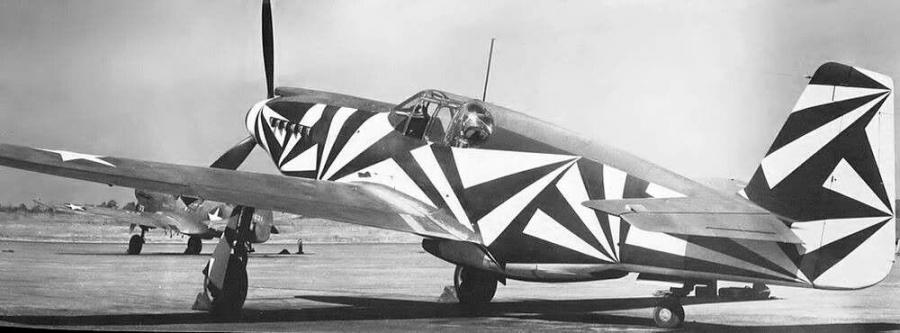
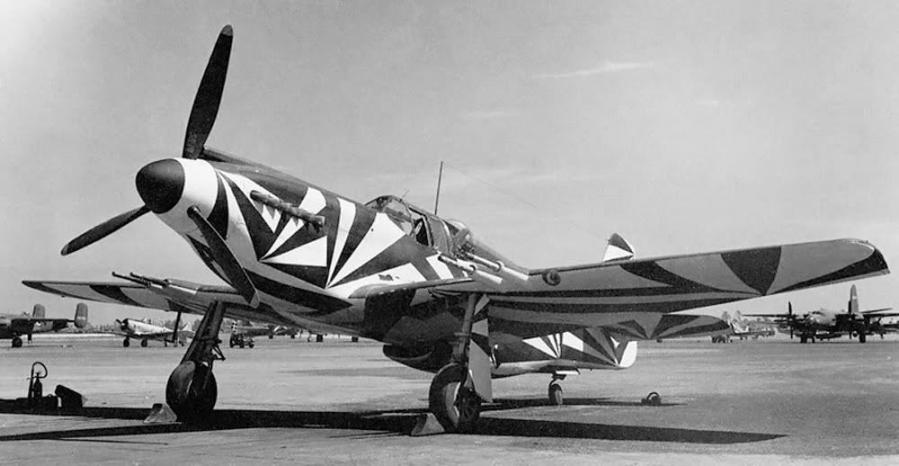
Mustang P-51A
Essai de camouflage éblouissant destiné à tromper sur l'orientation de l'avion.
Dazzle paint scheme designed to confuse the perception of the aircraft's orientation
© USAF - Domaine public - Public domain
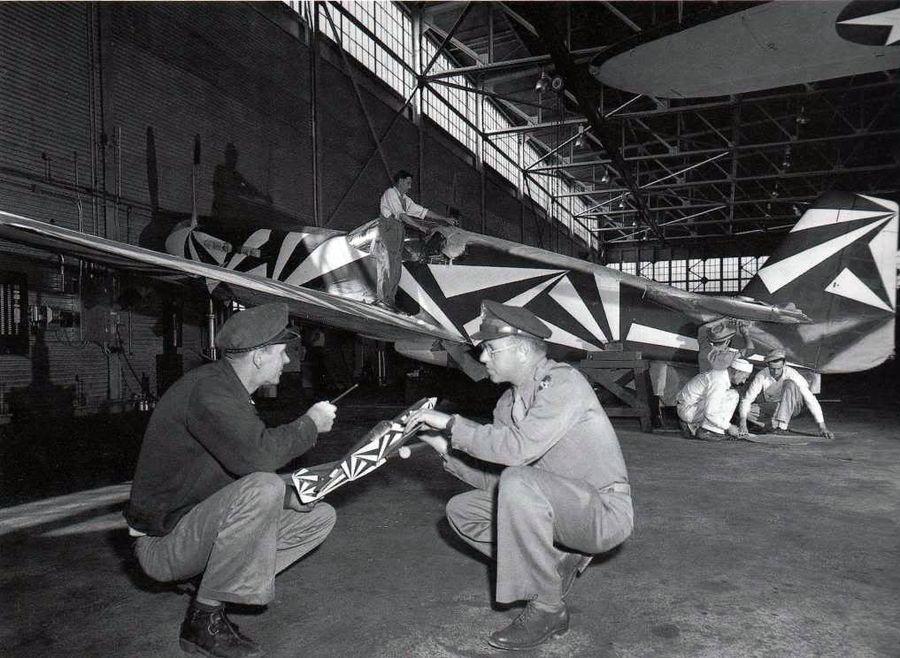
Mustang P-51A
Le Capitaine Paul Hexter à l'origine de ce test en 1942 - Captain Paul Hexter at the origin of this test in 1942.
© USAF - Domaine public - Public domain
P-51B-NA (& Mustang III)
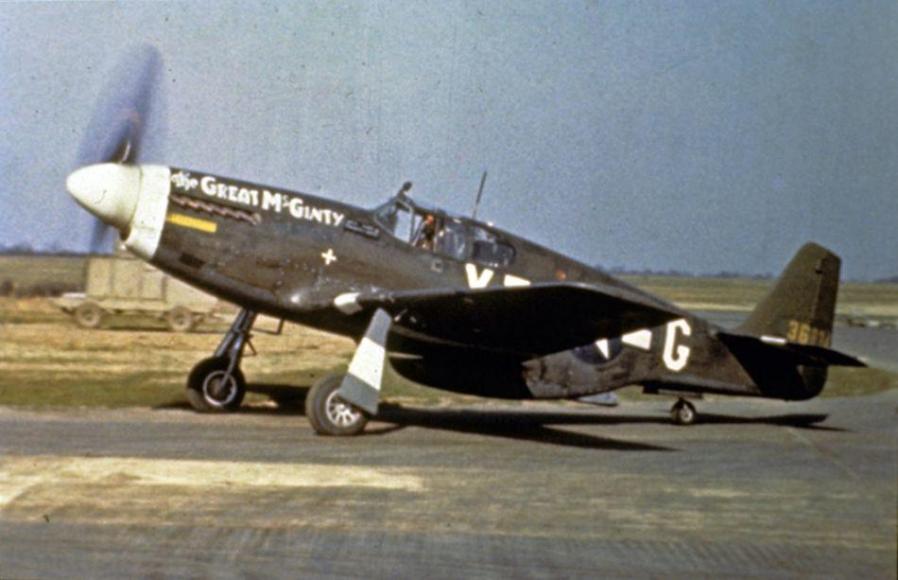
Mustang P-51B-5-NA 'The Great McGinty' YF-G (s/n 43-6834) 358th FS, 355th FG, Lt Bill McGinty, Angleterre/England, 1944
© USAF - Domaine public - Public domain
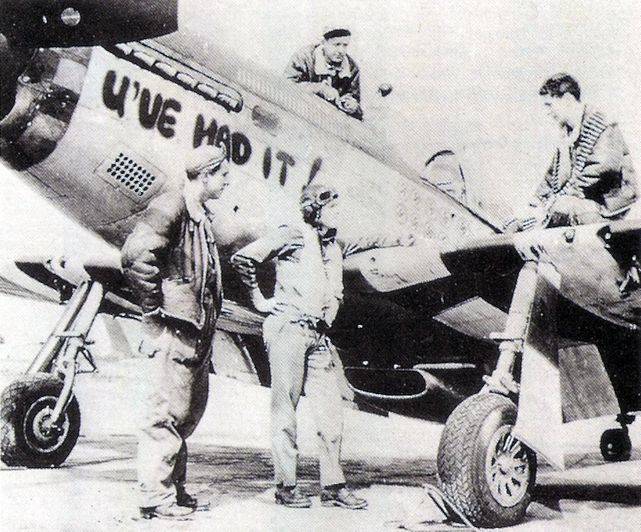
P-51B "U'VE HAD IT !", 362nd Fighter Squadron, Captain John B. England, été/summer 1944
© USAF - Domaine public - Public domain
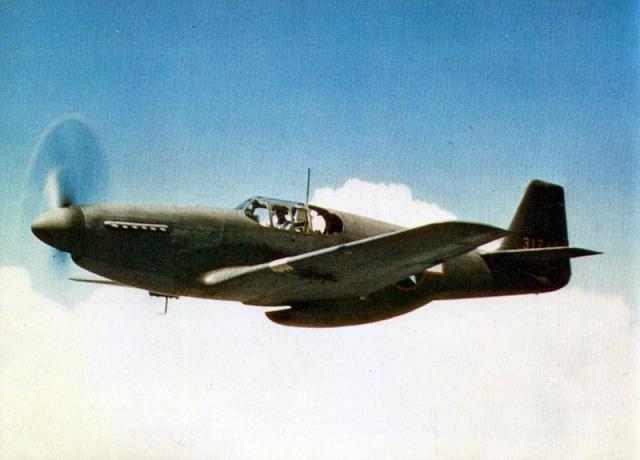
Mustang P-51B-1-NA
© USAF - Domaine public - Public domain
Le manque de performance et de fiabilité du moteur Allison conduisirent les anglais à tester un moteur Rolls-Royce Merlin 65 et les américains un Packard (Merlin) 65 V-1650-3. Un appareil (AG518) fut envoyé à Hucknall pour des essais de positionnement du moteur mais le prototype ne fut pas achevé.
he lack of performance and reliability of the Allison engine led the English to test a Rolls-Royce Merlin 65 engine and the American a Packard (Merlin) 65 V-1650-3. An aircraft (AG518) was shipped at Hucknall for engine positioning tests but the prototype was never finished.
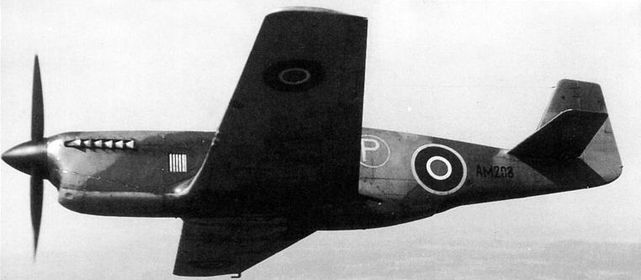
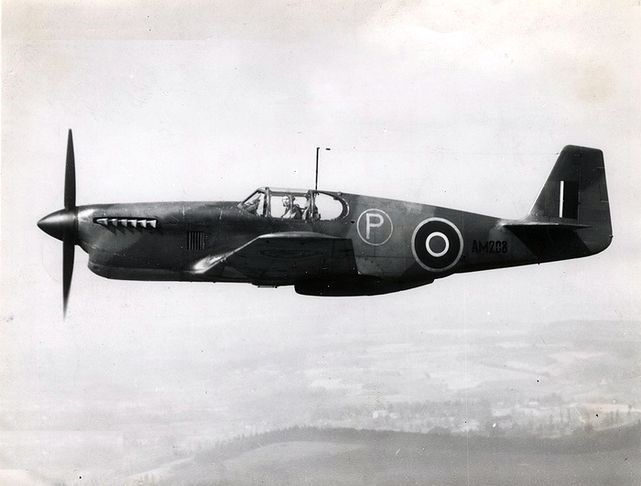
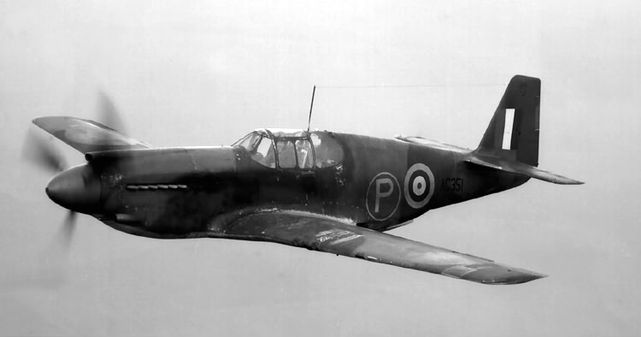
North American Mustang I AM208
Photos : source et auteur inconnus - source and author unknown
5 Mustang I (s/n AM121, AL963, AL975 et plus tard AM203 et AM208) furent attribués à Rolls Royce mi 1942 (à Hucknall) et furent appelés Mustang X (l'AL975 G fut le premier modifié).
5 Mustang I (s/n AM121, AL963, AL975 and later AM203 and AM208) were allotted to Rolls Royce mid 1942 (in Hucknall) and were called Mustang X. The AL975 G was the first one to be modified.
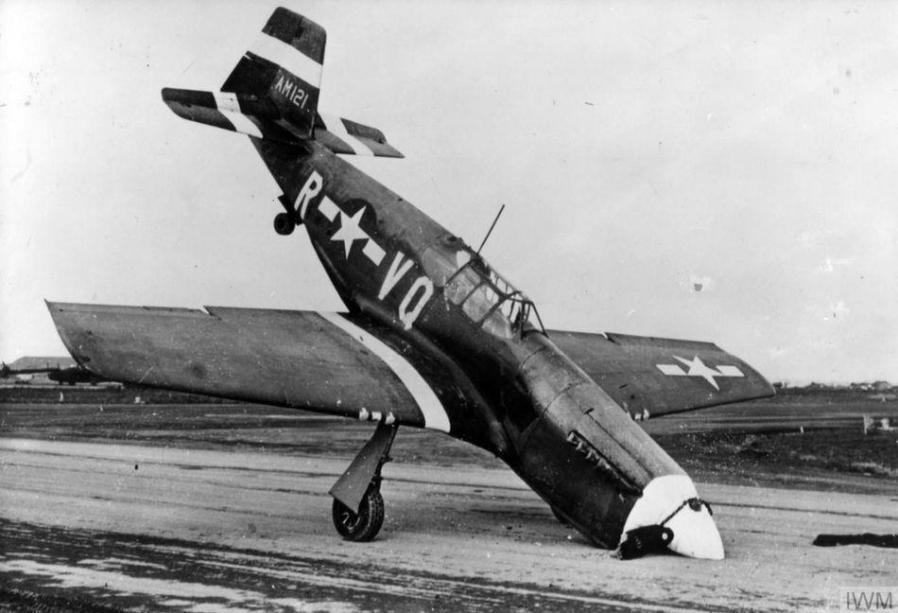
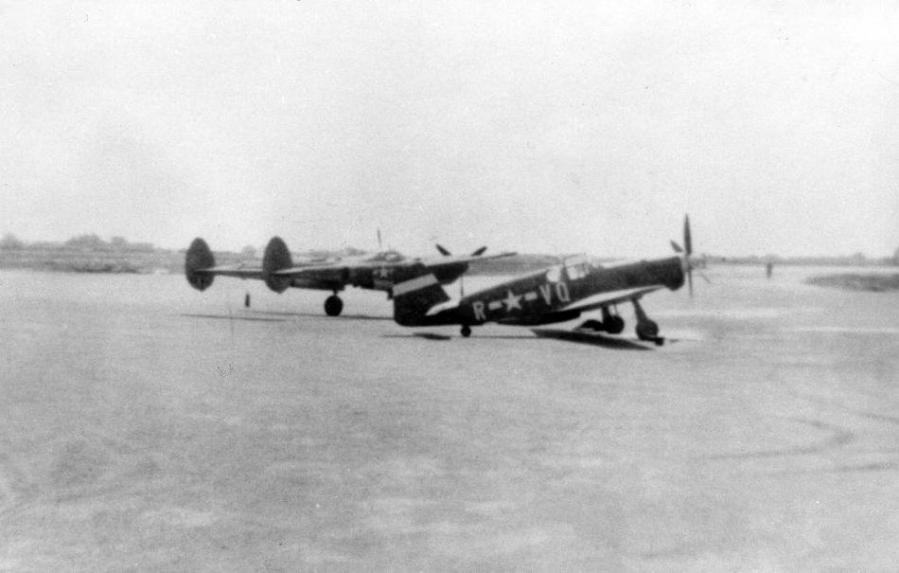
North American Mustang X AM121, 496th Fighter Training Group
© USAF - Domaine public - Public domain
Des essais anglais furent ensuite menés par Ronnie Harker, pilote d'essai de Rolls Royce ; Le Mustang X (AL975) prit l'air le 13 octobre 1942 à Hucknall : les essais furent positifs et l'avion atteignit 700 km/h à 7 600 m.
English tests were then carried out by Ronnie Harker, test pilot of Rolls Royce ; The Mustang X (AL975) flew on the 13th October, 1942, at Hucknall : the trials were positive and the aircraft reached 700 km/h at 7 600 m.
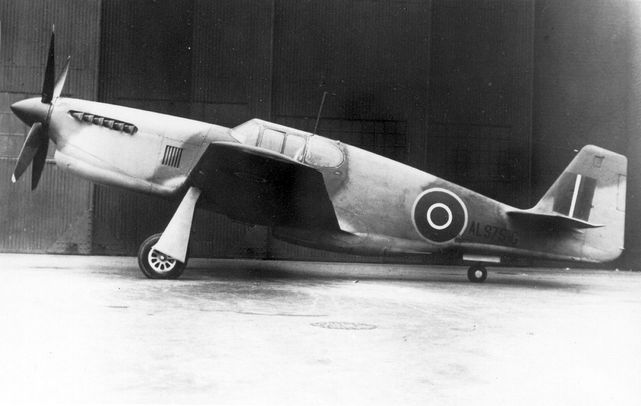
North American Mustang I AL975 G
© San Diego Air & Space Museum
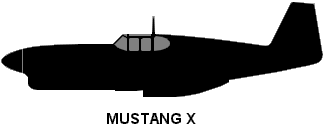
© Greg Goebel - Domaine public, public domain
Informé de ces essais, le Major Thomas Hitchcock, Attaché de l'Air à Londres, proposa le 25 juillet 1942 au Général Arnold d'imiter les Britanniques en utilisant le moteur américain Packard V-1650-3 (Merlin fabriqué sous licence) : c'est ainsi que furent utilisés les XP-51B.
Informed about these tests, the Major Thomas Hitchcock, American Air attache in London, proposed on the 25th July, 1942, to General Arnold to imitate the British by using the american engine Packard V-1650-3 (Merlin manufactured under licence) : thus were used the XP-51B.
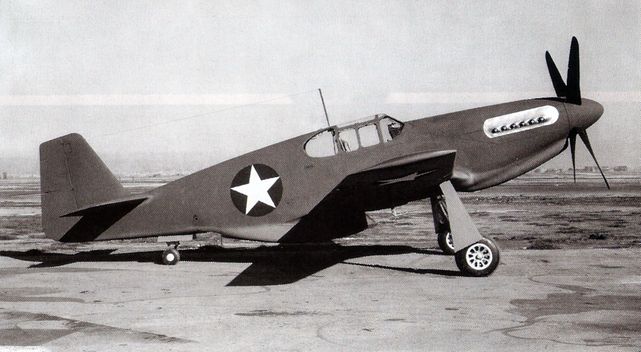
Mustang XP-51B
© San Diego Air & Space Museum
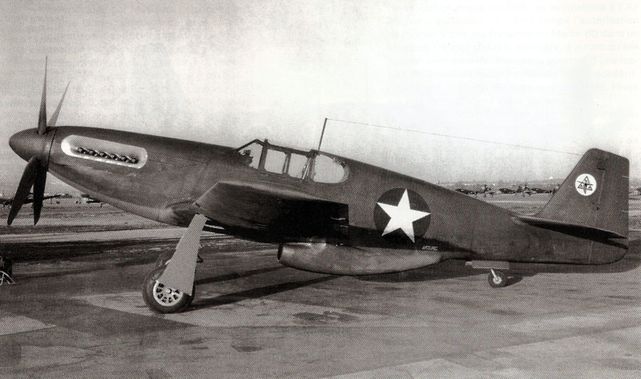
Un autre/another Mustang XP-51B
© San Diego Air & Space Museum
Le XP-51B vola le 30 novembre 1942 (pilote Bob Chilton) mais son moteur surchauffa. Les techniciens d'Inglewood procédèrent à quelques modifications pour corriger le problème de chauffe et adapter le moteur Packard ; parmi celles-ci, un radiateur plus large et une hélice quadripale Hamilton-Standard remplaçant la tripale Allison.
The XP-51B flew on th 30th November, 1942 (pilot Bob Chilton) but its engine overheated. The technicians of Inglewood made some modifications to correct the problem of heating and to adapt the Packard engine ; among those, a new larger radiator and a four-bladed propeller Hamilton-Standard to replace the three-bladed Allison.
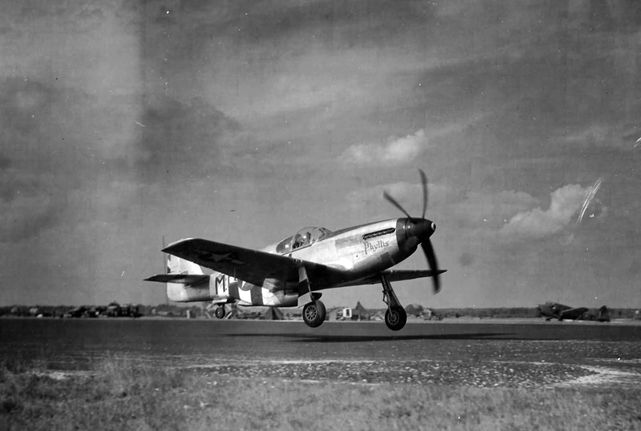
Mustang F-6C "Phyllis" (42-103211), code 5M-M, 15th Tactical Reconnaissance Squadron,
10th Photo Reconnaissance Group, Chalgrove (UK)
© USAF - Domaine public - Public domain
Environ 2 000 modèles P-51B furent produits dont 71 rebaptisés F-6C (équipés de caméras K-17 ou K-22) et 275 livrés à la RAF sous le nom Mustang III.
About 2 000 units of P-51B were manufactured including 71 renamed F-6C (fitted with cameras K-17 or K-22) and 275 delivered to the RAF under the name Mustang III.
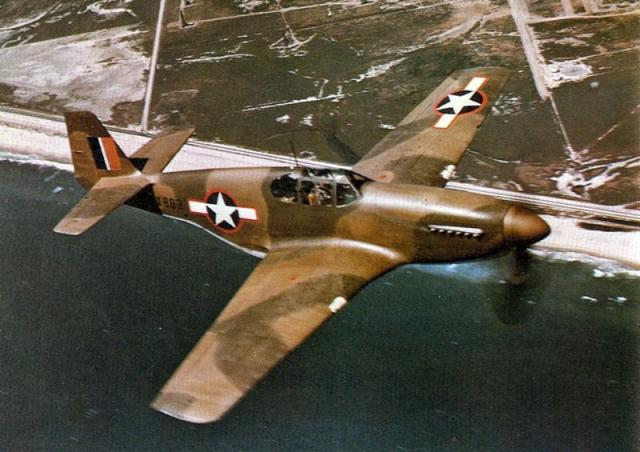
Mustang III (FX883)
© USAF - Domaine public - Public domain
Une décision du Général Arnold, qui souhaitait plus de chasseurs d'escorte, fit que des cellules prévues pour être des Mustang III pour la RAF furent finalement utilisées pour fabriquer des P-51B pour les Army Air Forces.
A decision of general Arnold, who expected more escort fighters, made that numerous cells which were supposed to be used to manufacture Mustang III for the RAF were finally used to manufacture P-51B for the Army Air Forces.
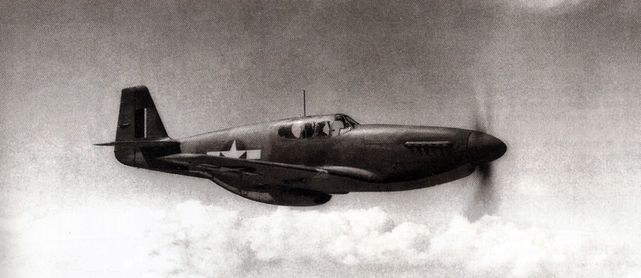
Mustang III
aux couleurs de la RAF, fut rétrocédé à l'USAAF ce qui explique l'étoile américaine
under RAF colors, was finally used by the USAAF which explains the american star
© San Diego Air & Space Museum (domaine public - public domain)
Pour faire face à la demande, N.A.A. decida de produire des P-51 B (sous le nom P-51C) dans son usine de Dallas, qui produisait jusque là des B-24 Liberator (modèles G et J) .
To meet the orders request, N.A.A. decided to manufacture P-51Bs (under the name P-51C) in its Dallas plant, which used to assemble B-24 Liberators (models G and J).
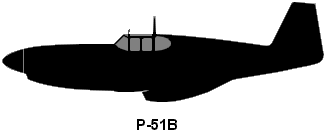
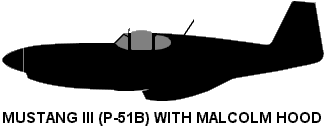
© Greg Goebel - Domaine public, public domain
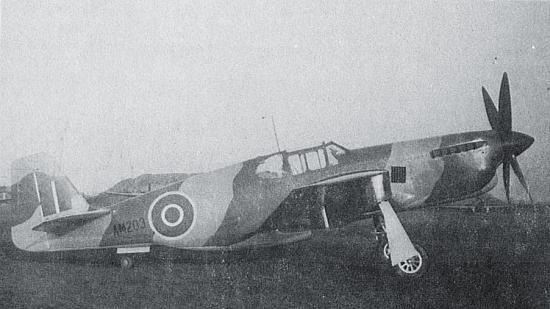
Mustang X (s/n AM203)
(source : United Kingdom Government - Domaine public - Public Domain)

Mustang P-51B (43-12093)
Tête de série - One of the first in production series
© San Diego Air & Space Museum
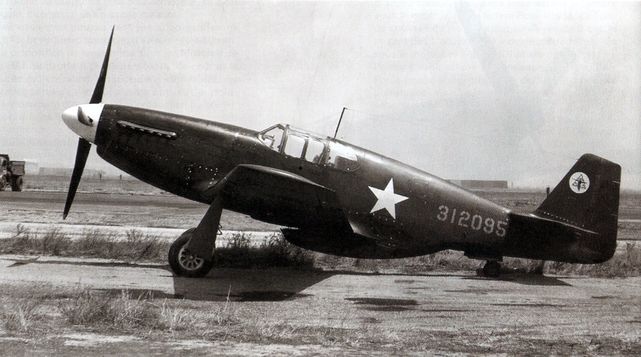
Mustang P-51B-1-NA (s/n 43-12095), Inglewood
(source : National Museum of the U.S.A.F. - Photo USAF - Domaine public - Picture U.S.A.F. - Public domain)
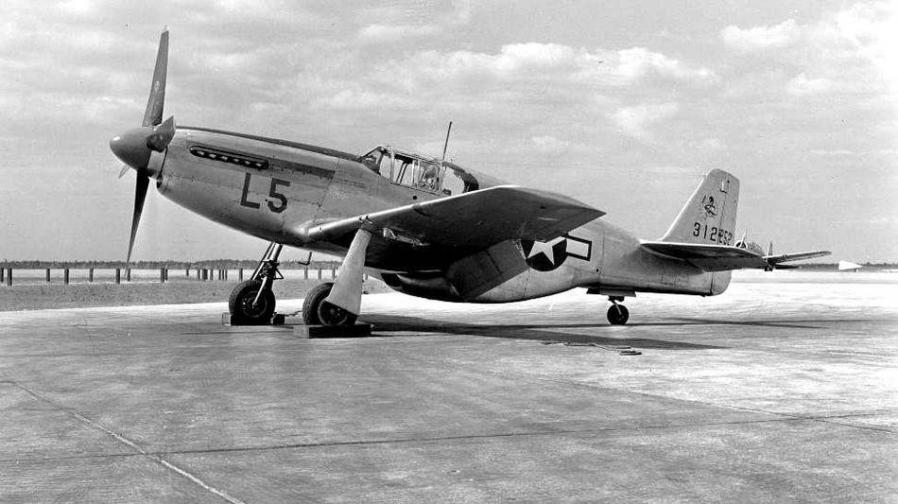
Mustang P-51B-1-NA (s/n 43-12252) 54th FG, Hillsborough Army Airfield, Floride/Florida, 17 Avril/April 1944
© USAF - Domaine public - Public domain
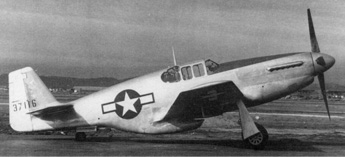
P-51B-10-NA (s/n 43-7116)
(Photo USAF - Domaine public - Public domain)
A cause d'une visibilité insuffisante, notamment vers l'arrière, la RAF équipa ses Mustang III d'une verrière moulée dessinée par R. Malcom. L'U.S.A.A.F. jugea cette amélioration importante et équipa des P-51 B (et C) de cette "Malcom Hood".
Because of a bad visibility, especially the rear visibility, the RAF fitted its Mustang III with a molded canopy designed by R. Malcom. The U.S.A.A.F. judged it was an important improvement and fitted some P-51 Bs (and Cs) with this "Malcom hood".


P-51 B-15-NA (s/n 42-106950) "The Iowa Beaut" - 354th FS, 355th FG, 8th AF, 1944
Photo FRE 6070 © IWM - www.americanairmuseum.com
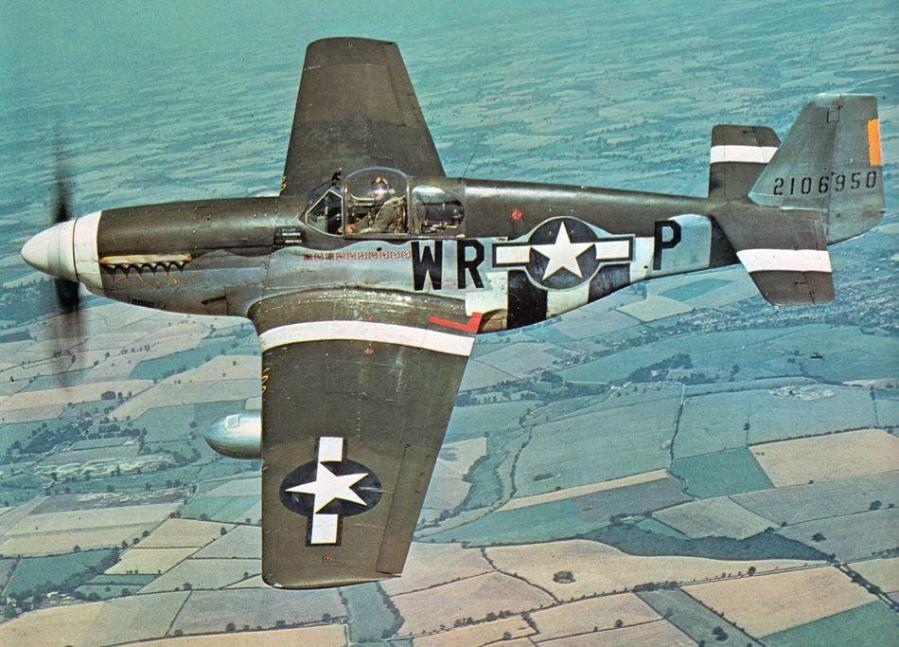
P-51 B-15-NA (s/n 42-106950) "The Iowa Beaut" - 354th FS, 355th FG, 8th AF, 1944
Photo FRE 25630 © IWM - www.americanairmuseum.com
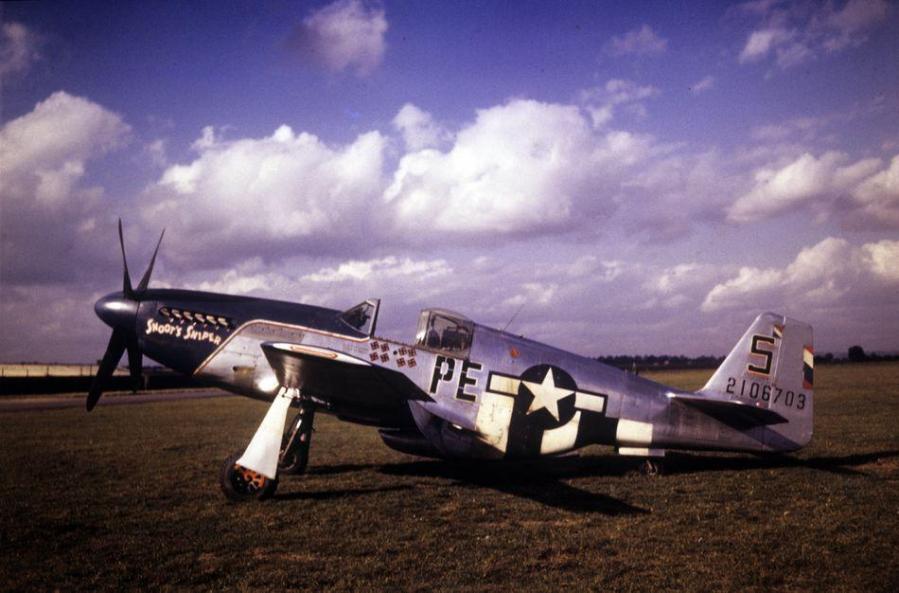
P-51 B-15-NA (s/n 42-106703) "Snoot's Sniper" - 352th FG, Grande-Bretagne/Great-Britain - 1944
Photo FRE 6016 © IWM - www.americanairmuseum.com
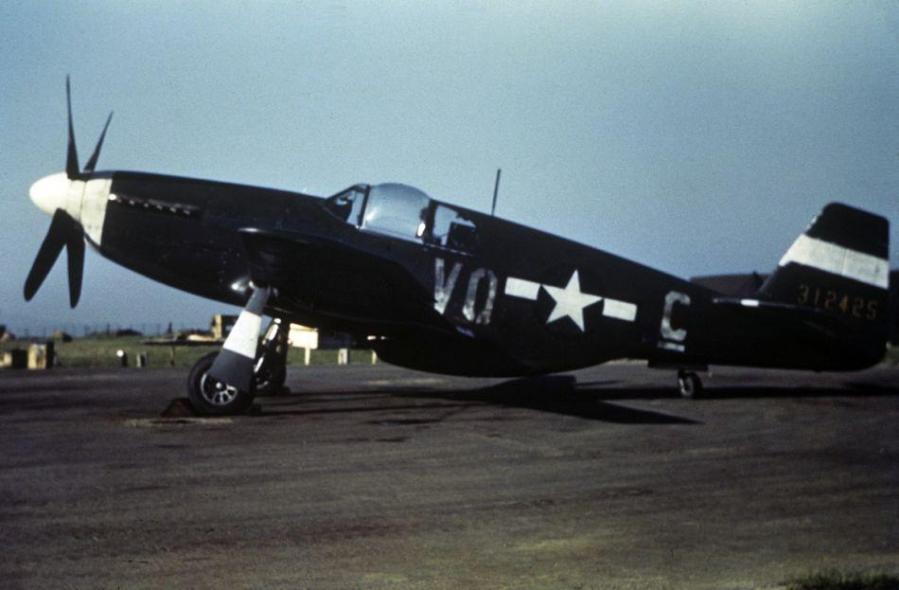
P-51 B-1-NA (s/n 43-12425) 7th PRG, 8th AF Technical Operations Squadron
Photo Robert Astrella FRE 6910 © IWM - www.americanairmuseum.com
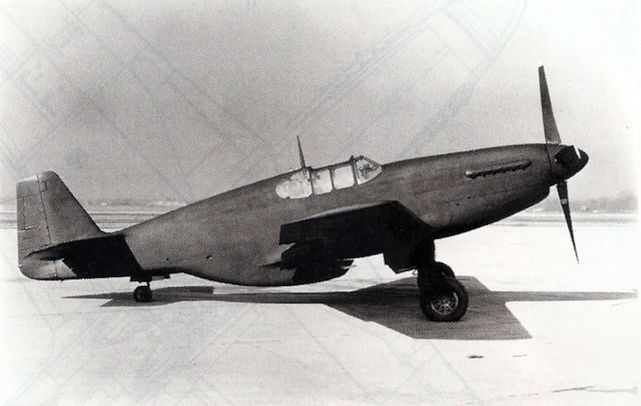

P-51B, camouflage de nuit, Inglewood, février 1944 - night camouflage, Inglewood, February 1944
© USAF - Domaine public - Public domain
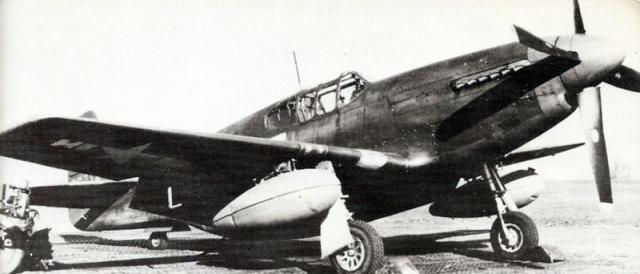
P-51B avec réservoirs de 284 litres - with 75 gallons tanks
© USAF - Domaine public - Public domain
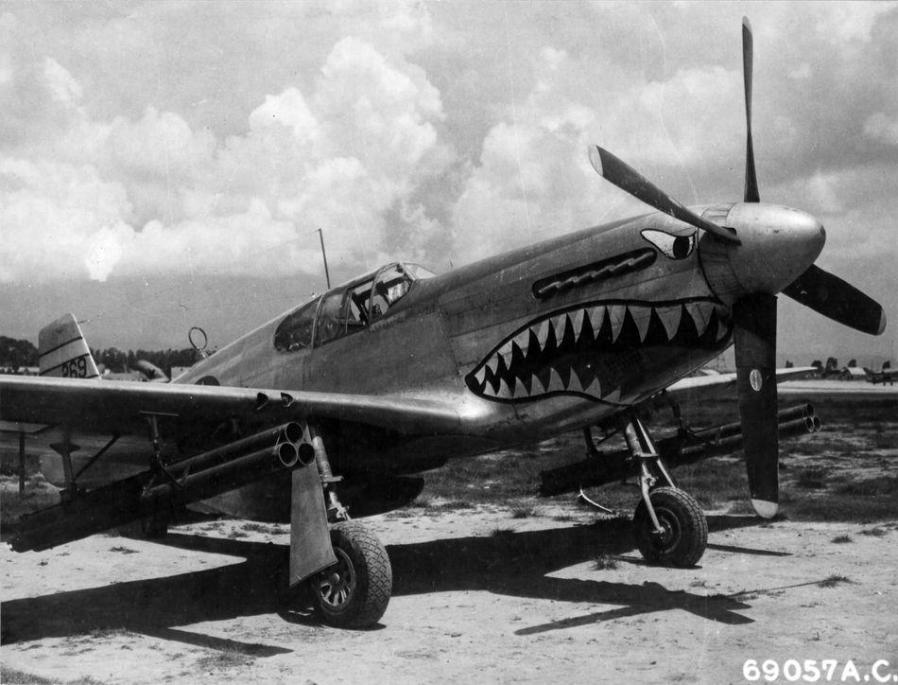
North American Mustang P-51B 14th Air Force - Chine, 17 juillet 1944 - China, 17 July 1944
© USAF (domaine public - public domain) NARA 342-FH-3A01070-69057AC
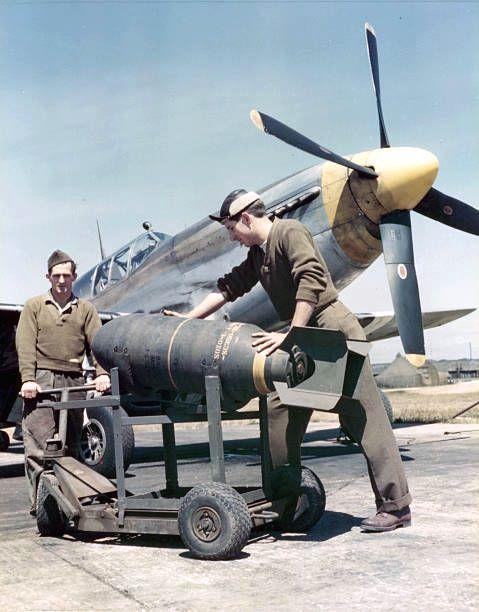
Mustang P-51B
Le Caporal Leroy Turner et le Sergeant Henry A. Buckoes chargent une bombe de 500 livres
Corporal Leroy Turner and Sergeant Henry A. Buckoks loading a 500 lb bomb
© USAF - Domaine public - Public domain
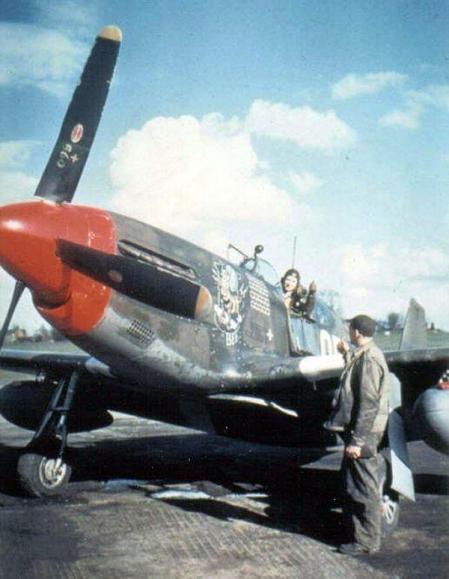
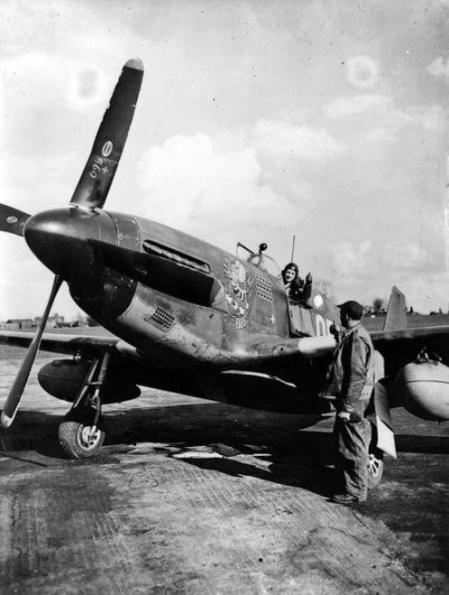
Mustang P-51B-5-NA (s/n 43-6819) 'Boise Bee', Maj. Duane Beeson & Crew chief Beeson, 334th FS, 4th FG, 8th AF
Photo UPL 21041 © IWM - www.americanairmuseum.com
